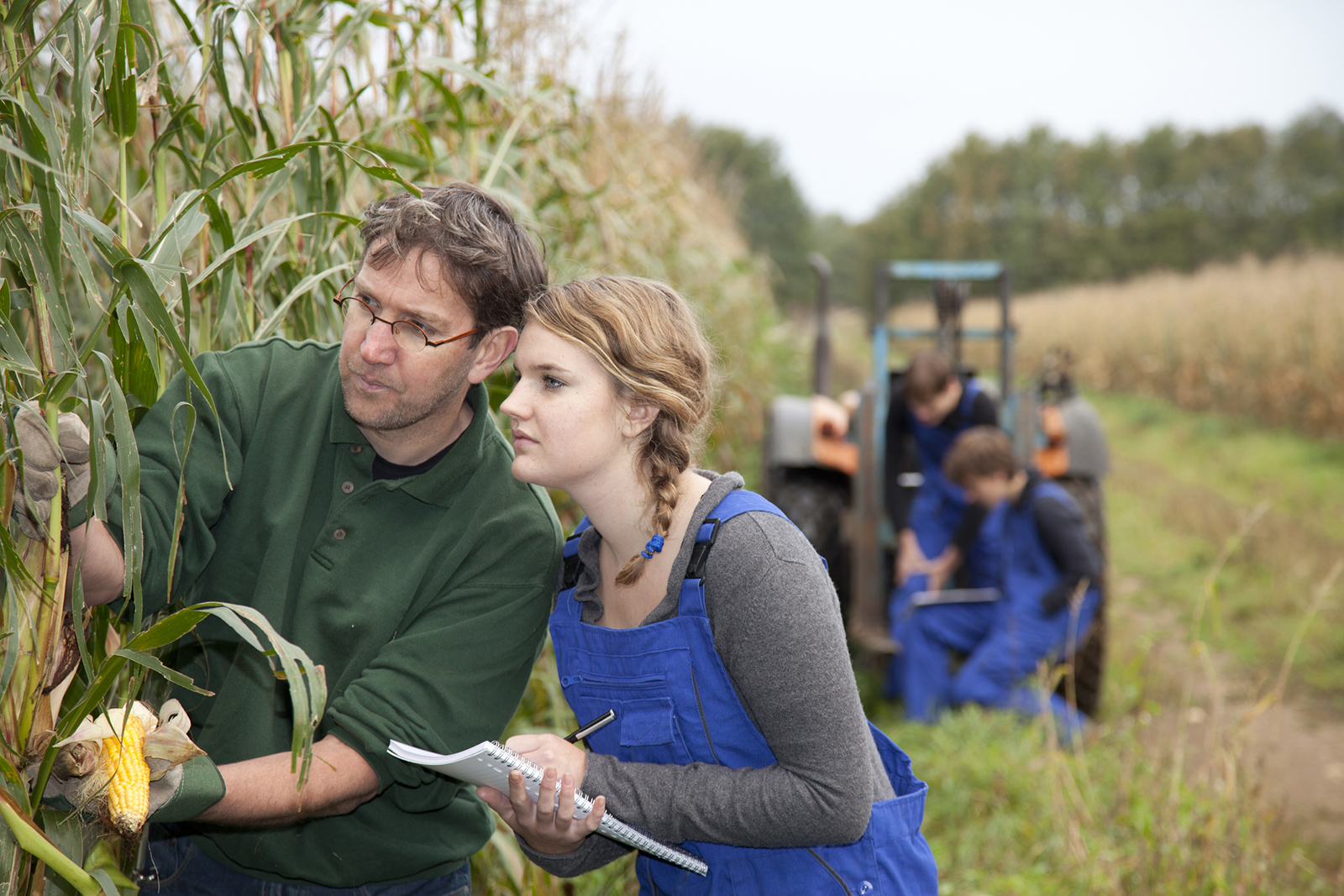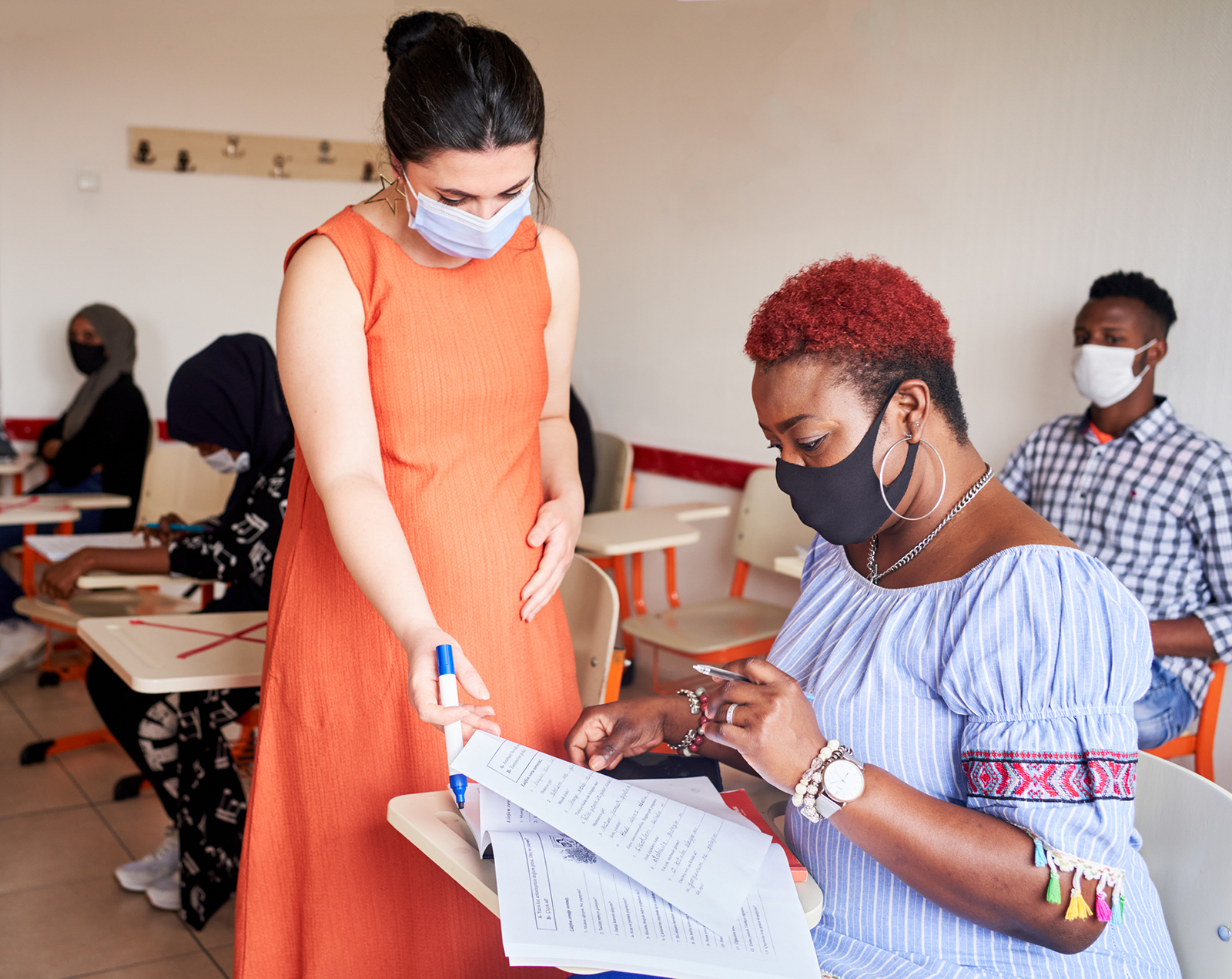Counties Support Post-Secondary Education and Workforce Opportunities for Residents

Upcoming Events
Related News
About NACo’s Landscape Analysis
In partnership with the ECMC Foundation, the National Association of Counties (NACo) conducted a national landscape analysis on counties’ role and decision-making authority in post-secondary education. This analysis identified impactful county efforts including directly allocating local funds, pursuing regional and intergovernmental partnerships to leverage federal resources and coordinating post-secondary education systems with county systems, such as health and human services, as well as with local private industry. Such efforts maximize educational and employment opportunities and increase access for residents. Recently, counties have led and supported their post-secondary education institutions in mitigating local challenges related to the coronavirus (COVID-19) pandemic. Through an electronic survey and group and individual interviews, NACo examined how county leaders:
- Make decisions affecting the post-secondary education sector;
- Allocate public funding impacting higher education institutions;
- Create partnerships with the post-secondary education sector to strengthen its connection with other systems; and
- Work to slow the spread of COVID-19 in post-secondary education settings.
Methodology
NACo’s methodology for this landscape analysis included the following components:
- An electronic survey sent to approximately 40,000 county leaders which collected quantitative data on counties’ decision-making authority affecting post-secondary education systems;
- Ten (10) one-on-one interviews with county leaders exploring local strategies for expanding career and educational opportunities for residents and how to foster strong partnerships with post-secondary education institutions; and
- A virtual focus group of national, state and county leaders to gather information on key considerations for counties in using best practice approaches and resources for establishing these partnerships and career pathways initiatives.
Key Considerations for County Leaders Seeking to Partner with Post-Secondary Education Institutions
|
Introduction
The county role in post-secondary education systems and adult education programs is not universal nor well-defined. Counties either have direct authority or work in coordination with a variety of sectors and systems that are intimately connected to post-secondary education institutions. When working in collaboration with higher education as key partners, county-based systems can build a solid foundation for residents in achieving economic mobility and lifelong success.
Despite the tremendous promise of post-secondary education systems, the full impact remains unrealized. According to Georgetown Public Policy Institute, about two-thirds of high-quality jobs require education beyond high school yet only 46 percent of working age adults possess that minimum standard.[i] Additionally, rapid changes in the economy present a greater need for workers to have the acquired skills and qualifications necessary to meet the demands of today’s workforce. Increasing county leaders’ understanding of their role and decision-making authority in post-secondary education can help address systemic barriers in residents in achieving educational attainment and gainful employment and the workforce needs of local industries. Expanding residents’ access to post-secondary and adult education supports and workforce readiness programs can improve their long-term outcomes and the local economy.
During the 2016–17 school year, there were over 25.6 million students enrolled in post-secondary education institutions and about 6.4 thousand higher education institutions located in our nation's counties. Of those surveyed, about eighty-four (84) percent of county leaders have a higher education institution located in their county, which includes 4-year universities and colleges, 2-year community or junior colleges or career and technical, vocational or trade schools. The vast majority of those institutions (87 percent) are public junior or community colleges, which shows the high level of public investment in higher education. The prevalence of public post-secondary education intuitions receiving public dollars or using public land or facilities shows promise for counties in leading activities that expand opportunities for higher education and career success. Counties can play a key role in creating an ecosystem of interconnected services and supports where higher education is involved as an active partner of countywide career pathways efforts.
According to Georgetown Public Policy Institute, about two-thirds of high-quality jobs require education beyond high school yet only 46 percent of working age adults possess that minimum standard.
Figure 1: HIGHER EDUCATION INSTITUTIONS LOCATED IN COUNTIES (N=104)
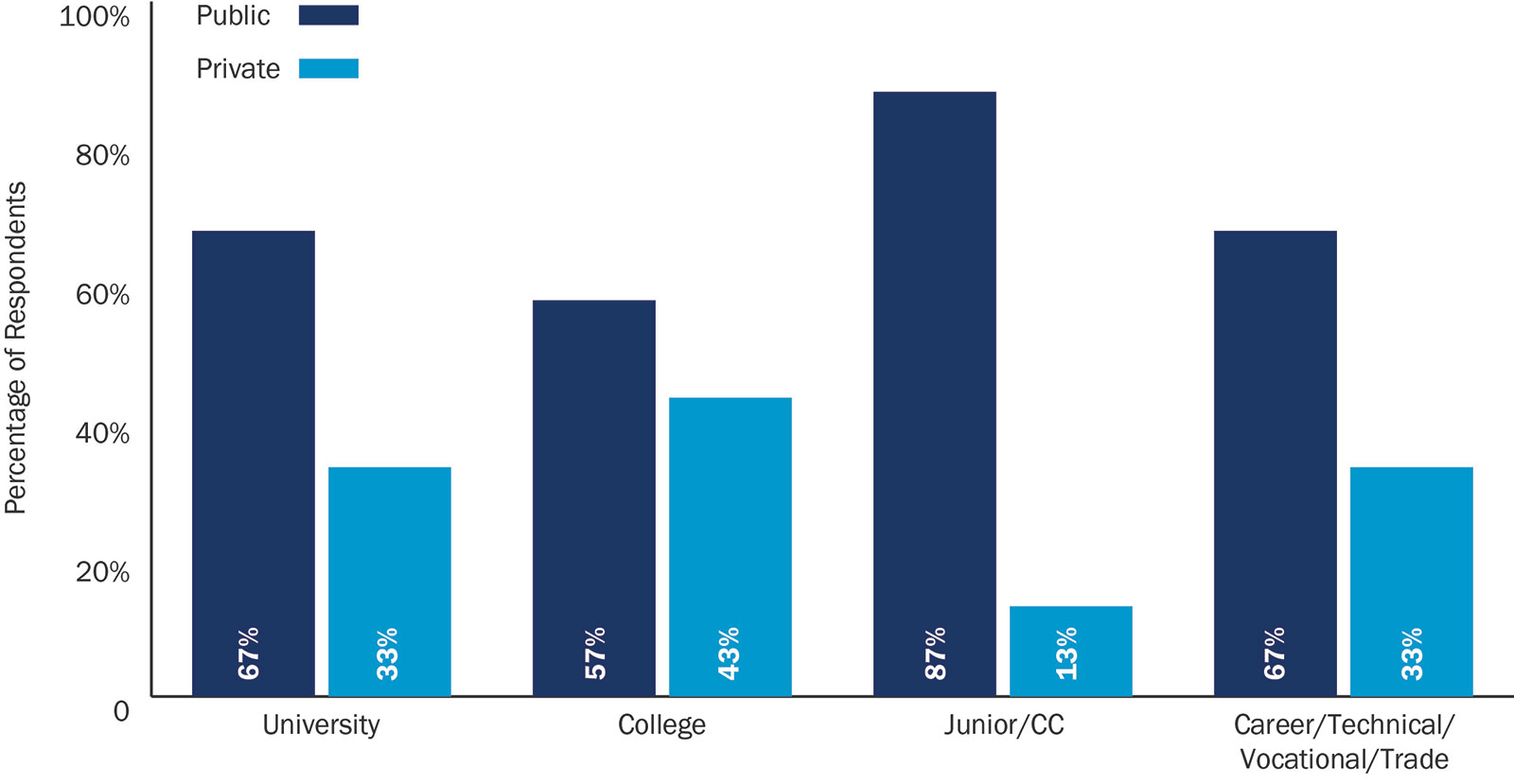
Over 257,000 county human services employees across the country deliver vital services to our nation’s most vulnerable populations.
Source: NACo County Explorer
Counties’ decision-making authority in the post-secondary education sector varies; however, counties remain critical actors in driving integration and coordination, among human services, workforce, and economic programs and systems to strengthen career pathways for residents. When these systems are coordinated with higher education, they can lead to lifelong, positive outcomes for residents. NACo found that counties are using cross-systems collaboration to streamline services and supports for residents. Increased coordination and collaboration among workforce preparedness training, food assistance and child care services can lay a foundation for long-term employment.
Counties are involved in 90 percent of the nation’s 550 local workforce development boards (WDBs).
Source: National Association of Counties
Throughout the coronavirus (COVID-19) pandemic, counties nationwide have employed novel solutions for protecting the health and well-being of residents. County partnerships among public health and higher education have been critical in helping to slow the spread of COVID-19 among students and employees in post-secondary education settings. Key findings in this report will explore best practices for promoting health and safety standards for slowing the spread of COVID-19 such as on-campus social distancing policies and increased sanitation of educational materials and facilities and improving access to online learning. NACo found that county public health departments’ coordination with higher education institutions is critical for successful implementation of public health standards.
Nearly 30 percent of WDBs operate within a county department or as a county agency.
Source: National Association of Counties
In June 2020, NACo surveyed county leaders to explore the county role and authority in the higher education sector and conducted a landscape analysis to explore the topic more deeply. This report highlights best practice approaches for county governments seeking to promote economic stability and career readiness opportunities for residents.
|
The County Role in Post-Secondary Education |
Post-Secondary Education Institution Types
Post-secondary education institutions provide education beyond high school and offer rich learning and academic experiences for students. They also offer skills-based training for adults who are interested in a certain profession or trade. Four-year universities and colleges create a traditional learning environment that is rooted in academic culture. Typically, students graduating from a 4-year institution obtain a Bachelor of Science or Liberal arts degree. Community or junior colleges typically provide students with a two-year education where they can obtain an associate degree or transfer credits to a 4-year institution to continue their education.
Some graduate schools and 4-year universities have institutes of technology that specialize in engineering, technology, applied science, and natural sciences.
Career and Technical Education (CTE) schools also offer students with an associate degree or short-term certificate of advanced education. CTE programs provide students with academic and technical skills, knowledge and training for gaining the necessary skills to be competitors in the job market and/or transfer credits to a four-year institution.[ii] These programs prepare students for careers such as paralegal or legal assisting, nursing aid, dental hygiene, business and finance, music, agriculture and arts and design. CTE full course completion typically requires about 60 credit hours of instruction or 4 semesters of education.
Trade schools also offer smaller units of credit hours that are designed to train students for a specific job in a skilled trade career and provide hands-on training to prepare students for immediate work in their chosen field.[iii] Trade schools typically offer flexible class schedules to accommodate life obligations, such as family or job responsibilities.[iv]
Vocational programs are in both secondary and post-secondary education systems to prepare students for emerging occupations that may not require a bachelors or advanced degree.[v] Examples of trade or vocational programs and careers include electrical technician, hair or nail technician, operations management, plumbing and landscaping and may require continuing education while in the profession. With vocational programs, students can earn their degree faster and save money on tuition compared to four-year institutions.
Continuing education and workforce development programs (e.g., credential, certificate or licensure, professional development and training, skills-based learning) offer adult learners non-degree, non-credit professional programs designed for enhancing knowledge and skills in a particular area leading to a license or credential.[vi] Continuing education courses are conducted by private organizations, local professional boards, colleges and universities. Some schools may offer certificate programs, but the focus of continuing education is on non-credit courses for students to develop skills in a specific area of interest.[vii] These programs can benefit adults who seek to enhance their skills in a particular profession or have the necessary credentials for employment, as required by their profession or licensing board. Employers may give employees flexible work hours during their course time or a period of study or subsidize course fees if the coursework is related to their position.[viii]
 |
Counties’ decision-making authority in post-secondary education systems
Counties’ decision-making authority affecting post-secondary education systems and adult education programs (i.e., non-degree, credit-bearing education) is not universal nor well-defined. This authority includes the ability to fund and establish local policies impacting higher education institutions.
Counties are governed by locally elected officials and, in some instances, operate under home rule authority, which allows for more local flexibility and control on structural, functional and fiscal powers. These positions include elected county executives that have oversight of county-based agencies and budgets and county commissioners, council members and supervisors that advance local polices and advise on county services. Local authority may involve the ability to develop and approve budgets, establish tax rates, issue bonds and create public corporations, provide services and perform multitudinous tasks associated with the day-to-day operation of government.[ix]
Most counties, however, operate under the more restrictive “Dillon’s Rule,” where local authority is expressly granted by the state. Though organizational structures vary, all county, parish and borough governments deliver vital services and support to residents.
Of those surveyed, about 33 percent of county leaders said that their county board makes decisions affecting post-secondary education system policy. Approximately half of respondents indicated they make decisions regarding funding (54 percent) or through their collaborative efforts involving post-secondary education institutions (50 percent). Examples include providing funding for post-secondary educations’ facilities, operations and programs and leading and participating in cross-sector collaboration efforts to improve coordination among county-based employment and workforce preparedness services.
Figure 2: COUNTY ROLE IN DECISIONS RELATED TO POST-SECONDARY EDUCATION (N=48)
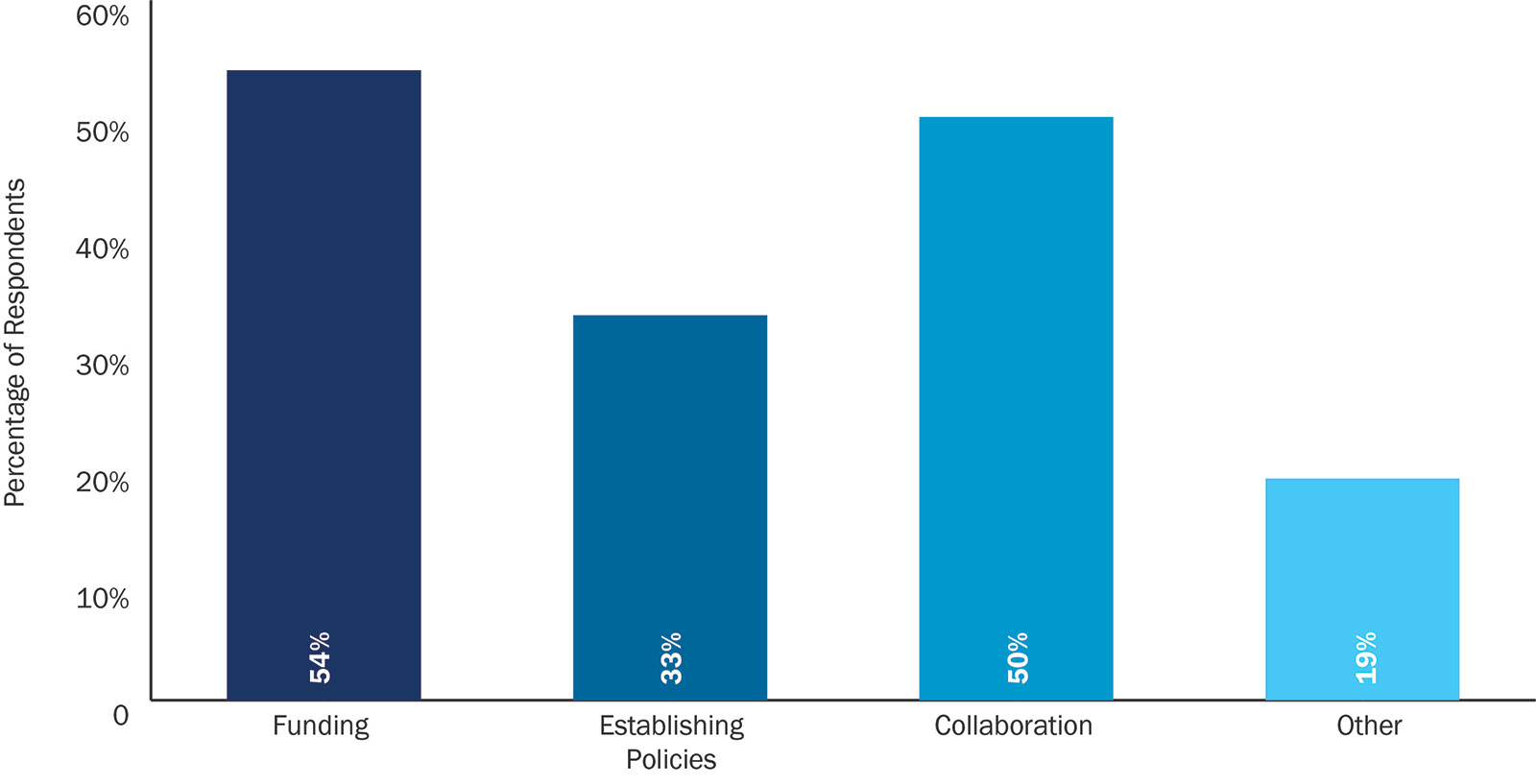
According to NACo’s survey, county leaders serve on and appoint members for community college boards of directors, have contracts with universities to help maintain campus buildings and provide other services, and extend public transportation routes to improve access and connectivity to higher education institutions. County leaders also work with community colleges and technical schools in developing programs and curriculum that prepare students for trade jobs and technical careers, especially for jobs that are in high-demand. Whether a county has significant or minimal authority in making decisions on higher education, county leaders show commitment to improving educational attainment and workforce readiness for residents through local investments alone.
County funding for post-secondary education systems and its programming
While funding for post-secondary education systems may derive from federal, state or local sources, counties invest in higher education. One quarter of county leaders (24 percent) indicated they fund higher education systems within their county. This funding demonstrates counties’ commitment in supporting the establishment and sustainability of local universities and community colleges regardless of the level of authority. Counties fund and have significant decision-making authority in public land use and own public facilities, especially involving public schools and some higher education buildings. County investments also fund financial aid for students such as student loans, grants, scholarships and paid internships to promote college affordability.
Counties invest more than $600 billion annually in delivering essential services.[x] Education is the third largest source of expenditures for counties. In FY2017, county expenditures for education included $103 billion for construction and maintenance of public school buildings and support for post-secondary education.[xi] County expenditures for higher education included $9 billion, and 86 percent of this spending is for campus operations.[1] This amount also involves direct funding to 2-year junior colleges or community colleges, 4-year universities and graduate schools such as law, medical, engineering and business administration schools and agricultural colleges, land grant institutions and other institutions granting post-secondary education degrees. In response to NACo’s survey, county leaders noted their top investments in higher education include direct funding to colleges and universities (58 percent) and continuing education and workforce development programs (52 percent).
Figure 3: County Higher Education Expenditures

[1] U.S. Census Bureau definition of Current Operations: Direct expenditure for compensation of own officers and employees and for supplies, materials, and contractual services except any amounts for capital outlay (i.e., for personal services or other objects used in contract construction or government employee construction of permanent structures and for acquisition of property and equipment). U.S. Census Bureau. (2006) Government Finance and Classification Manual. Retrieved from: https://www2.census.gov/govs/pubs/classification/2006_classification_manual.pdf
 |
County expenditures also include campus supplementary services, which are partially or largely funded through fee for service contracts and operated on a commercial basis. Some of the highest expenditures in FY2017 involved direct funding and support for the maintenance of dormitories, cafeterias, athletic facilities and bookstores. Other expenditures include post-secondary educational resources for instruction, research, public service (excluding agricultural extension services), academic support for college students, libraries, other student and administration services and plant maintenance and services regarding student health services.
One key strategy for customizing educational offerings to meet local needs, especially in rural counties, is the local college extension office. Extension offices provide non-formal education and learning activities for farmers and other residents of rural communities to engage them in research, education and jobs in agricultural fields. Through extension offices, land-grant colleges and universities bring vital, practical information to agricultural producers, small business owners, consumers, families and young people. For example, Maui County, Hawaii funds faculty and staff positions at its local college’s extension office as a part of its partnership to promote agriculture and create local solutions to addressing climate issues. The University of Hawaii’s College of Tropical Agriculture and Human Resources serve the citizens of Maui County by providing science-based research, education and public service and bringing community solutions and filling gaps in agriculture, natural resources, food and nutrition, food safety and community development.[xii] In Maui County, this work is driven by the college’s faculty and staff of its Cooperative Extension, which is located in Kahului and Hoolehua, and the Maui Agricultural Research Center located in Kula.
According to the U.S. Department of Agriculture’s National Institute of Food and Agriculture, “the hallmarks of the extension program — openness, accessibility, and service — illuminate how cooperative extension brings evidence-based science and modern technologies to farmers, consumers, and families [and are designed to offer resources to address public needs]. By educating farmers on business operations and on modern agricultural science and technologies, extension [offices] contribute to the success of countless farms, ranches, and rural businesses. These services improve the lives of consumers and families through nutrition education, food safety training, and youth leadership development.”
Source: U.S. Department of Agriculture
County extension offices are prevalent in rural communities where there are careers and educational opportunities in agriculture and other industries in close geographic proximity to local residents. Post-secondary education institutions, whether university, community college or vocational or trade school, can offer a wide range of educational programming that prepares students for the skillsets needed for local industry jobs. While this approach presents significant opportunities for county residents, post-secondary education leaders must also understand the rural challenges that create roadblocks for students seeking higher education and training that are often tied to community conditions. Such challenges include rural poverty, limited access to transportation and traditional and non-traditional child care, food insecurity and lack of broadband access.
Research shows that locales designated as rural have higher poverty rates and lower education levels than those labeled urban, suburban or town.[xiii] While college graduates earn on average 70 percent more than nondegree holders, this may not be the daily experience for residents in economically depressed areas.[xiv]
Regardless of population density, cross-sector collaboration and continued county investments for higher education can lead to educational opportunities that equip students with skills needed for local industry jobs, generate sustainable employment opportunities, and breakdown systemic and economic barriers that affect student matriculation and graduation rates. Higher education and public sector leaders can also bring private industry and federal partners to the table to help sustain jobs and expand well-compensated employment opportunities for residents experiencing economic challenges within their community.

Federal Investments in Regional and Local Workforce Development |
The Workforce Innovation and Opportunity Act (WIOA) is a key funding and policy lever that provides federal funding to states and counties for a wide range of workforce development and job training programs for jobseekers and employers. Administered jointly by the U.S. Departments of Labor and Education, WIOA empowers state and local governments to connect individuals with in-demand skills training and education, and businesses to skilled jobseekers.[xv]
WIOA fosters a partnership among federal, state and local government, which supports counties in delivering employment and job preparedness services through workforce development programs and American Jobs Centers (AJCs).[xvi] State and local WIOA workforce development boards (WDBs) and AJCs are a central component of WIOA. WDBs offer flexibility for localities in establishing workforce policies and programs unique to their community and local challenges. Local WDBs have oversight of one stop career centers and are responsible for leveraging public funding, coordinating and facilitating multiple strategic partners representing businesses, higher education and human services and workforce agencies, providing strategic direction and tracking accountability. Regionally, WDBs can involve one county or several counties, and based on local need, they generate resources and bring together public and private sectors to increase job readiness and employment opportunities.[xvii] Additionally, local elected officials are responsible for appointing board members, which must include representatives from local businesses and education, labor and community-based organizations.
AJCs, also known as one stop career centers, are centralized in local communities and provide free assistance to jobseekers by connecting them to a variety of career and employment services and educational and job placement supports.[xviii] Services may include assistance on interviewing skills, referrals to employment workshops, hiring events and job counselors and access to resource rooms with phones, computers and educational materials to support them in job seeking and preparedness. WIOA funds are leveraged locally to create these person-centric, one stop career centers for residents to access tailored education and training services and receive streamlined case management services.

Coordination and Collaboration for Improved Workforce Outcomes |
County Coordination with Higher Education
According to NACo’s survey, about 41 percent of counties have a career readiness and/or educational attainment initiative that includes partnership with higher education. Many of these initiatives are driven by WIOA state and local efforts and help prepare students for in-demand jobs. Hennepin County, Minn. has a research sharing program and opportunities for student internships. DeKalb County, Ga. also has a summer jobs program in partnership with local universities and colleges and supports institutions by providing public land and authorizing use.
Regular communication is key for creating strong partnerships across multiple departments and sectors. Workforce development boards, businesses, county departments of health and human services and post-secondary education institutions are coming together to share data on workforce needs, develop training and curriculum and reach high schoolers and the adult workforce with programs and services. In response to NACo’s survey, county leaders told NACo that having access to data across multiple systems is critical for informing local decisions affecting higher education institutions and improving community outcomes. Hamilton County, Tenn. county health department coordinates with the county community college to provide educational opportunities for trade jobs in high demand and careers such as nurses and medical technicians. The county also works with local high schools in promoting its local community colleges at job fairs to enhance college enrollment for residents. In Dakota County, Minn. and Shelby County, Ohio, local workforce boards and post-secondary education institutions work together to offer training for local careers in great demand and engage disconnected workers in employment. This strategy helps improve the local economy by working to reduce employment barriers and retain jobs for skilled workers who live in the county.
County Coordination with Human Services
County-based human services systems also play a role helping to reduce employment and education barriers for low-income residents. For example, Allegheny County, Pa.’s human services department hires, trains and funds navigators for the Community College of Allegheny County (CCAC) to connect college students to county resources, such as housing or behavioral health services and economic support programs. In Solano County, Calif., recipients of the Temporary Assistance for Needy Families (TANF) cash assistance program are connected to post-secondary education institutions to enroll them in CTE programs.
The 2014 reauthorization of WIOA encouraged coordination among the Temporary Assistance for Needy Families program (TANF) and other public assistance programs to support educational and employment outcomes for low-income residents.[2] The goal is to reduce duplication and improve program coordination for efficient service delivery among these critical safety net and employment programs and systems. Many states leverage their WIOA efforts to coordinate child care and transportation services for residents to increase their participation in workforce preparedness, education attainment and employment services. WIOA funds may be transferred to programs such as the Supplemental Nutrition Assistance Program (SNAP) and TANF to support the needs of low-income residents seeking and obtaining employment who also struggle with food insecurity. Funding for SNAP and TANF are top policy priorities for counties as they offer flexibility in program standards and local administration of services for both low-income parents and their children.[xix] Additionally, some localities leverage TANF funding to provide financial assistance for recipients to engage them in post-secondary educational or professional certificate and/or licensing programs.
“TANF programs help facilitate recipients in meeting their education and employment goals but can also coach parents in supporting their children and achieving economic security for their household. TANF eligibility varies based on state and local income eligibility standards, household size and earnings and other factors. Meanwhile, workforce agencies are better connected to training providers and have more intensive employer relationships than TANF welfare-to-work programs. For these and other reasons, experts suggest that aligning programs will reduce duplication of services (such as resource rooms for job search) and generate cost savings.” – The Center for Law and Social Policy
Coordination among behavioral health services and TANF can increase recipients’ access to counseling to help them cope with life stressors and manage behavioral, mental, emotional or substance abuse issues that often become barriers to employment. For instance, in Allegheny County, Pa., the county community college and human services department’s partnership on the navigator program also includes a behavioral health and housing component to the model. This approach helps address underlying factors that often hinder educational attachment and employment.
Similar to WIOA, TANF is also coordinated with child care programs for recipients to access affordable, quality child care for their children while they work or seek employment. When income eligibility programs such as TANF, SNAP and child care subsidy are well coordinated with WIOA, they can help eliminate economic barriers affecting participation in work and education, improve the customer experience and streamline case management services for low-income residents. Coordination can occur within a local WIOA one stop career centers or person-centered, integrated human services systems.
[2] WIOA uses outcome measures like employment and earnings, while TANF uses a different type of measure called Work Participation Rate (WPR). The WPR is a process measure, showing whether recipients were present at countable activities for the required number of hours. It does not measure whether these activities increased the participants’ subsequent employment or earnings. To receive credit toward the WPR, states must monitor and document all hours of participation. This distinction has been well-documented as a barrier to coordination between TANF and workforce systems. Cielinski, A. (May 2017). Coordinating TANF & WIOA High Interest, Slow Progress During Early Days of WIOA. The Center for Law and Social Policy. Retrieved from: https://www.clasp.org/sites/default/files/publications/2017/08/Coordinating-TANF-and-WIOA.pdf
 |
County Coordination with Local Industry
County leaders are partnering with post-secondary education institutions, local businesses and major corporations, chambers of commerce and workforce development boards to identify and develop programming designed to maximize the skills needed for local industry jobs. They are using promising practices and leading collective impact approaches to support the human capital needs of residents and the workforce needs of local employers working for major corporations and small businesses.
Data sharing among intergovernmental and private industry partners can be used to increase transparency and solve community problems such as unemployment, lack of job growth and limited post-secondary education programming and curriculum that matches the small business and local industry jobs in counties. For example, Wilson County, N.C.’s NCWorks has a data dashboard where job seekers and employers can gain access to local labor market data and post-secondary education matriculation rates. Employers and job seekers can also learn more information about the occupations in high demand and the educational, job and salary requirements necessary for being a competitor in today’s job market. Holding regular meetings with cross-sector partners that include post-secondary education institution leaders, employers and workforce development directors can also support collaboration on higher-education programming, curriculum and coursework and training and credential programs designed to promote the skillsets needed for jobseekers to be prepared for local industry jobs.
Cross-sector partners can also create opportunities and collaborate on programming for internships and apprenticeships that create a pipeline for career readiness, upward mobility and job success. Recognizing the tremendous growth in health care innovation, research and technology, Tarrant County, Texas government, post-secondary education institutions and hospitals partner with medical centers to hire directly from the county’s university and college medical and nursing programs. Local officials work with the North Texas Health Science Center at Fort Worth to offer internship opportunities, hands-on-training and part-time employment for future medical workers and technicians. Leveraging these approaches can help build a highly qualified, well-trained workforce, create job opportunities in small businesses and support growing and emerging industries that drive the local economy.
State and Local Coordination
Counties also coordinate with state and city governments to improve policy, increase funding, streamline services and systems building efforts and share data to promote career readiness opportunities for residents. About half (49 percent) of counties partner with state or city government on issues affecting post-secondary education, according to the leaders who responded to NACo’s survey.
Cities and counties have been coming together to create regional approaches for strengthening educational and career pathways and partnering with local community colleges. They share data and information on student enrollment and basic needs and identify and assess the educational and work preparedness needs of local industries. In many counties, WDBs are the lead partners that bring together multiple municipalities and coordinate local efforts with the state.
In Allegheny County, Pa. for example, one WDB represents both the city of Pittsburgh and the county of Allegheny on their workforce efforts. Additionally, Erie County, Pa.’s workforce development board is regional and brings together elected officials from five counties. Several Arizona counties participate in a statewide education improvement initiative. For example, Santa Cruz, Ariz. is a member of its local higher education consortium and Coconino County, Ariz. is part of the Arizona Tri-Universities for Indian Education to improve educational attainment and opportunities for Native American residents.
While there are benefits in collaborating multiple sectors and systems, there are also some challenges and barriers. NACo asked counties about the barriers in coordinating higher education with other systems such as human services, workforce and employment. Thirty-seven (37) percent of county leaders reported that staff capacity is a significant barrier. Other challenges include turf wars, restrictive requirements (mostly from the state) and challenges with data sharing. Moreover, lack of clarifying roles when leading cross-systems collaboration efforts and misalignment of interests across systems were also key barriers.
Figure 4: BARRIERS IN COORDINATING HIGHER EDUCATION WITH OTHER COUNTY-BASED SYSTEMS SUCH AS WORKFORCE DEVELOPMENT, EMPLOYMENT AND/OR HUMAN SERVICES
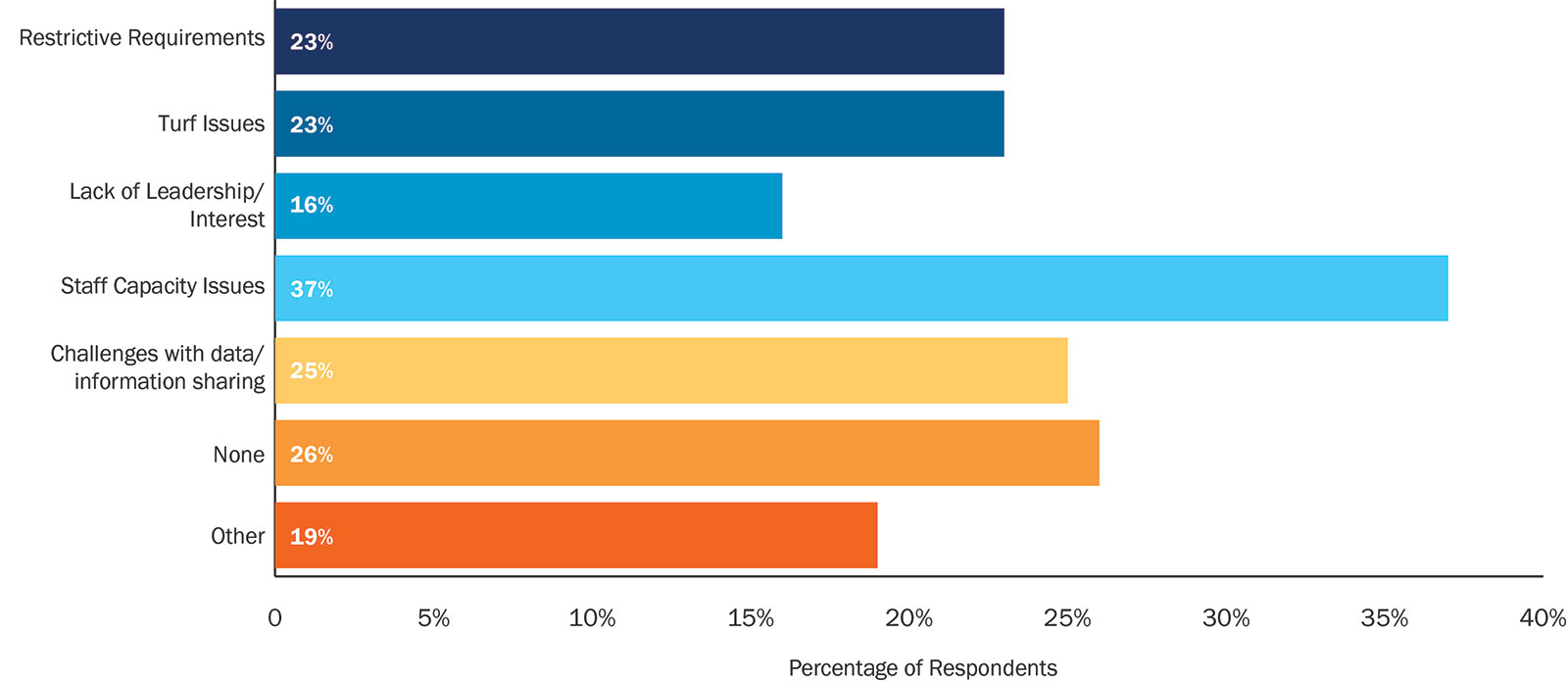
As counties start to work with public and private partners, local leaders can plan ahead to clarify roles and needs and consider thinking through and voicing asks in the beginning stages of planning. Counties can also consider collective impact approaches and action planning methods for bringing together cross-sector partners.[xx]

Slowing the Spread of COVID-19 |
According to NACo’s survey, about 50 percent of county leaders believe that post-secondary education institutions will see budgetary impacts as a result of COVID-19. Of those counties, about 20 percent are providing aid to the higher education sector to offer immediate support and help sustain institutions during the pandemic.
Source: National Association of Counties
The coronavirus (COVID-19) pandemic greatly impacts America’s counties. County leaders are making crucial decisions daily and employees and first responders are on the front lines helping to support residents in response to this pandemic. Counties are implementing intergovernmental efforts to slow the spread of COVID-19. They are increasing resources for COVID-19 testing, contact tracing and health care services for residents testing positive with the virus while mitigating negative impacts on local economies, jobs and budgets.
As post-secondary education leaders consider standards for reopening, many institutions have applied a combination of in-person, distance learning and hybrid approaches to promote health and safety standards for students, educators and other staff. Some institutions have completely shifted to online educational activities where possible and others have implemented in-person learning with social distancing, mask use and other safety measures to keep individuals healthy and safe. In Durham County, N.C., post-secondary education institutions offer online learning only. The county scaled back funding for student housing as dormitories are not in use during the pandemic. Higher education institutions also reduced classroom sizes and prioritized in-person learning for freshman and senior classes, which are crucial milestones in students’ lives.
Erie County, N.Y. is a part of the State University of New York’s (SUNY) post-secondary education system. The county indicates that “SUNY Erie is planning on mostly remote learning in the fall, front loading practical labs as early in the semester as possible.”
Reopening policies for post-secondary education systems may differ based on program and institution type. For instance, technical, vocational and applied studies institutions with nursing, construction and mechanical courses that require in-person instruction are applying health and safety standards to continue educational coursework and activities during the pandemic. Post-secondary education institutions have leveraged federal, state and local guidance to inform social distancing practices among students and sanitation standards for educational tools and materials that require hands on use. In Dakota County, Minn., the community college is now 95 percent online, with campus involvement reserved for labs and clinicals. Meanwhile, the county’s technical college has about 40 percent of its course instruction and programs using an on-campus approach. In these settings, mask requirements, reduced classroom sizes, thermometer checks, testing and contract tracing are being used to prevent the spread.
Counties are involved in promoting public health through 1,943 local health departments.
Source: National Association of Counties
County health departments have also played a lead role in collaborating with post-secondary education institutions. County health departments protect residents and communities by offering a wide range of services like administering flu shots, providing health information and preventing and responding to public health emergencies.[xxi] From hospitals and emergency rooms to clinical care facilities, counties operate the systems that serve residents beyond COVID-19. Counties provide critical health services that keep residents healthy from the time they are born to the time they grow old. Counties also often have significant responsibilities for behavioral and mental health services and care, which has been essential for serving residents during the pandemic and beyond. These services have been working in coordination with higher education to ensure that students’ well-being is addressed and basic needs are being met, especially during this public health crisis. This effort has become paramount as educational facilities and programs reopen.
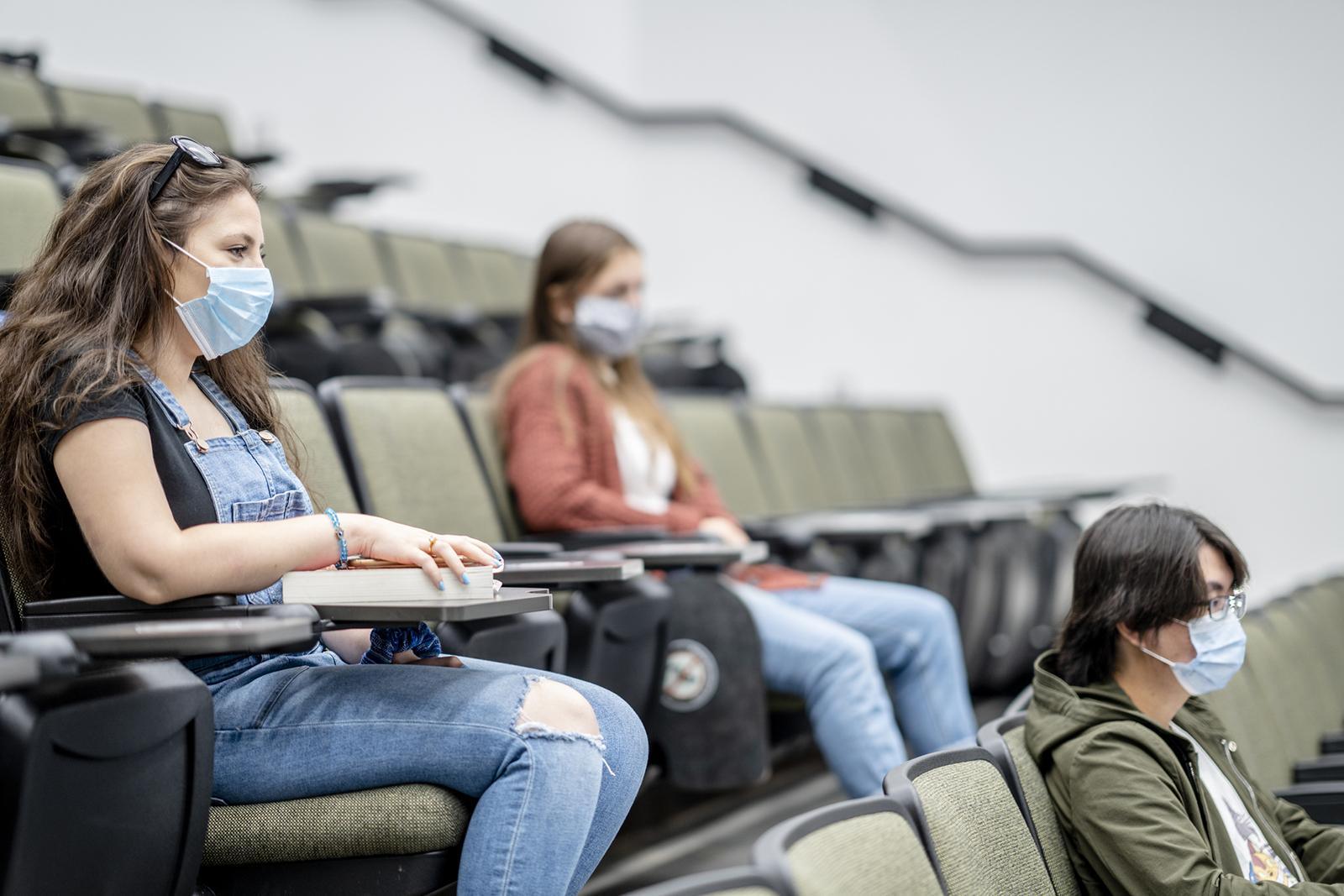 |
Counties also leverage the fiscal year (FY) 2020 Coronavirus Aid, Relief and Economic Security (CARES) supplemental funding to provide one-time support to health centers in the detection, diagnosis, prevention, and treatment of COVID-19. Counties used CARES funding to maintain and expand health center capacity and staffing levels to help address coronavirus-related conditions and emergency efforts.[xxii] County leaders are also leveraging local resources to create informational and educational materials for promoting COVID-19 health and safety measures from the Centers for Disease Control and Prevention and statewide polices. These materials are often posted in local facilities and spaces, such as hallways of post-secondary education institutions. Like other facilities, colleges and universities are posting “6-feet apart” stickers on walkways for students to maintain social distancing standards.
In Erie County, Pa. the county health department worked with colleges and universities over the summer to prepare for the fall semester. Health department leaders held daily calls with pandemic coordinators at various higher institutions, especially when COVID-19 cases were rising in the county. Tarrant County, Texas regularly convenes stakeholders, including post-secondary education leaders to collect and share data and discuss potential re-opening policies for colleges and universities in the county. The county also works with post-secondary education institutions to deploy medical residents and interns and nursing students in county health centers to expand public health services to residents exposed to the virus. During the pandemic, Yavapai County, Ariz. used state and county data to develop a phased reentry plan for reopening local colleges and universities. These precautions will continue as counties track COVID-19 cases and data trends and any changes in state polices and regional efforts.
During the 2020 economic downturn, county governments and community colleges have closely monitored any potential negative impacts on higher education expenses as a result of the pandemic. Post-secondary education leaders have had to make tough decisions like cutting operational and program costs and furloughing staff. Job positions that have been mostly impacted include custodial and maintenance workers who are not able to work remotely and where there is a limited need for services and use of certain campus facilities. In Allegheny County and at the beginning of April 2020, CCAC furloughed 116 part-time employees and reduced full-time staffs’ work schedules to cut costs.[xxiii] However, CCAC was able to continue their health care benefits while furloughed. While some higher education institutions were able to leverage CARES funding for immediate relief, there is great recognition that government investments and cross-sector partnerships are needed to help sustain post-secondary education systems and programs.

Conclusion |
County authority in post-secondary education differs across the United States. While local government may not have direct oversight over colleges and universities, county leaders generally contribute to decision-making boards and bodies affecting higher education institutions. County elected officials and agency directors tend to serve on university and college boards, participate in and lead WIOA and other cross-sector initiatives to promote career readiness opportunities for residents and they engage in statewide and regional efforts bringing programs and funding to scale. Counties also make direct funding allocations to post-secondary education systems within their jurisdictions, particularly to support operations and facilities costs, financial aid for tuition assistance and equipment to help students prepare for local jobs.
Understanding the various state and county governance structures, authorities and available services is critical for county leaders seeking to identify the right levers to pull to ensure high-quality jobs can be filled by county residents. NACo’s research suggests that cross-sector partnerships are critical for advancing strong post-secondary education systems that promote human capital and help residents gain the necessary skills for being competitive in today’s local job market.
For a county’s most vulnerable residents, county-based human services systems play a role in helping to reduce barriers to education and employment. Residents experiencing economic hardship, food insecurity and employment barriers often interface with multiple programs and systems to gain support in obtaining training and employment. These programs and systems usually operate in silos, offering duplicative services to common problems. Multiple touchpoints for food assistance, child welfare and care, reentry and workforce development systems can be challenging for consumers to navigate and find the resources they need to develop relevant skills. NACo’s research also shows that counties can be critical actors in driving integration across economic development, workforce and human services systems and in promoting community college enrollment for local residents.
Moreover, county leaders can leverage their partnerships with local chambers of commerce and industry executives to explore what skills are needed for today’s jobs and where local industry is headed. By being proactive about the future of work in local communities, county leaders can help increase employment opportunities by guiding the development of higher education programming matched to the skills needed for high-quality jobs in local industries. They can use data to identify and address disparities affecting long-term, sustainable employment outcomes. County elected officials and directors of human services agencies and workforce development boards can use that information to improve post-secondary educational programming and leverage their partnership to increase enrollment, particularly for low-income residents and others experiencing barriers in achieving gainful employment. This approach can help shift the mindset of “having a job” to “sustaining a career” and support transitions from welfare to work.
Through coordination and collaboration, counties can create a comprehensive, multifaceted system of educational and employment supports that lead to improved outcomes for residents. National models and resources are needed for counties to develop and maintain coordinated cross-sector partnerships with post-secondary education systems, local industry and human services in pursuit of strategic workforce development plans that are person-centered and support economic mobility and local economic growth.
Case Studies
|
Tarrant County, Texas |

Tarrant County, TexasCase Study Interviewee(s): Commissioner Roy Charles Brooks, Tarrant County, Texas; Past President, NACo County Landscape
About Tarrant County, TexasTarrant County, Texas is the third largest county in Texas and located in the north-eastern region of the state. The county maintains a civilian labor force of just over 1 million workers, with their largest industries being retail, professional services such as financial and engineering, technology and other forms of applied science, and health care and social service assistance.[i] The county role in post-secondary educationSimilar to other counties in Texas, Tarrant County is governed by a Commissioner’s Court comprised of a county judge and four commissioners. Because the county operates under Dillon’s Rule, most of the power and authority of the county is determined by the state constitution and legislature.[ii] While the county does not have direct decision-making authority in higher education (i.e., university programming, operations and other functions), county government leaders are deeply involved in collaboration activities with post-secondary education institutions and in connection with its local workforce development board and health care centers. Cross-sector leaders meet regularly to improve educational attainment and job readiness opportunities for residents within the region. Funding for post-secondary education institutions and programmingHigher education institutions within Tarrant County are managed and funded by their respective governing entities and therefore, do not typically receive funding from the county. For instance, Tarrant County College (TCC) is governed by a board of trustees comprised of seven members elected by the voters of Tarrant County. TCC’s board has the ability to leverage local taxes to fund the school’s operations and the construction of their physical facilities. TCC’s largest revenue sources are supported by local taxes, tuition and state appropriations.[iii] While Tarrant County does not regularly allocate funds to its post-secondary education institutions, the county provides funding for university research focusing on health disparities and other issues. For example, the County Commissioner’s Court approved a $1 million grant for the University of Texas Southwestern Medical Center and Texas Health Resources to conduct a research study examining the effects of the coronavirus (COVID-19) on high-risk populations and explore socio-economic, racial and ethnic factors of approximately 45,000 residents living in Tarrant and Dallas counties. Findings from the study will be used to create equitable public health strategies for local communities.[iv]
Coordination and collaboration for improved workforce outcomesTarrant County’s colleges and universities partner with workforce development boards on activities that promote positive educational and employment outcomes for residents. Tarrant County’s workforce development board, Workforce Solutions for Tarrant County (WSTC) is funded by the Workforce Innovation and opportunities Act (WIOA), which falls within the state’s authority and oversight. However, WSTC is operated at the county-level and assists local residents by providing them with services and supports for job readiness. WSTC leads community stakeholder meetings where participants advise on workforce readiness programs that support unique skillsets of job seekers and discuss the needs of local employers. WSTC collaborates with post-secondary education institutions to connect students with job opportunities. Since it was established, WSTC has provided nearly 5,000 students with adult education and literacy services and connected approximately 26,000 job seekers with employment.[v]
To advance the county’s workforce efforts, Tarrant County’s Resource Connection facility operates as a one-stop center for individuals seeking education, employment, health or human service resources. The 300-acre campus, owned by the county, houses nearly 40 different county agencies and community-based organizations that assist hundreds of clients daily. The facility is fully funded through the rent payments of the tenant agencies and the county’s role is to provide administrative management and security services for the tenants. Having these services co-located in one facility helps streamline case management and improves consumers’ access to services. As they describe in their promotional materials, “the Resource Connection is a mecca for public-private collaboration, cross-agency cooperation and service integration.”[vi] For students who are experiencing economic hardships, post-secondary education institutions coordinate with this center to offer services that increase their access to food and housing, which are often barriers to higher education. In Tarrant County, post-secondary education institutions and hospitals are key partners, with medical centers hiring directly from the county’s university and college medical and nursing programs. In August, the County Commissioner’s Court approved a $1.9 million contract, funded by the Coronavirus Aid, Relief, and Economic Security (CARES) Act, to provide North Texas Health Science Center at Fort Worth’s (HSC) students with resources and materials for conducting contract tracing in partnership with the Tarrant County Public Health Department. The partnership will allow 90 students to be employed part-time and gain hands-on training in a public health emergency while helping to mitigate the impact of COVID-19 on the community.[vii] Slowing the spread of COVID-19 in post-secondary education settingsAs the COVID-19 pandemic persists, post-secondary education institutions within Tarrant County are reopening in a variety of ways. The county’s public health department works with each institution to accommodate their needs, particularly on health, safety and operations. In weekly meetings, the department convenes community stakeholders such as city managers and councils, state legislative delegations, school districts and administrators as well as hospital personnel to share information and assess the impacts of the pandemic across the community. Cross-sector partners bring data to stakeholder meetings to help inform decisions on COVID-19 and help mitigate its impacts. The county then compiles this data into a COVID-19 dashboard to give a holistic picture of the developing situation in the community.[viii] The Tarrant County Public Health Department uses this data to advise and offer guidance to post-secondary education institutions in the county on protocols for on-campus learning and how best to respond to spikes in cases. Additionally, while the county did not have the authority to allocate CARES funding to these institutions to cover pandemic-incurred costs, officials were able to supply personal protective equipment (PPE) to educational institutions and community-based organizations. ConclusionOverall, due to Dillon’s Rule, Tarrant County’s decision-making authority on post-secondary education systems and its ability to fund them is limited. However, the county has strong partnerships with post-secondary education institutions to support students’ educational success and help meet the county’s workforce development goals. The importance of these existing partnerships has become even more evident during COVID-19 and have allowed for a strong collaborative effort to mitigate the impacts of the pandemic on the community. [i] Tarrant County, Texas. (n.d.). Labor Force and Employers. http://www.tarrantcounty.com/en/administration/staff/economic-development-coordinator/financial-status/labor-force-and-economic-base.html [ii] National League of Cities. (2016, December 13). Cities 101 — Delegation of Power. https://www.nlc.org/resource/cities-101-delegation-of-power/ [iii] Tarrant County College. (2021, January 28). Board of Trustees. https://www.tccd.edu/about/administration/board-of-trustees/ [iv] UT Southwestern Medical Center. (2020, July 10). UT Southwestern, Texas Health launch collaborative study to better understand COVID prevalence in DFW. https://www.utsouthwestern.edu/newsroom/articles/year-2020/dfw-covid-prevalence-study.html [v] Workforce Solutions for Tarrant County. (n.d.). Who We Are. https://workforcesolutions.net/about-us/who-we-are/ [vi] Tarrant County, Texas. (n.d.). Resource Connection of Tarrant County. https://www.tarrantcounty.com/en/resource-connection/About.html [vii] Smith-Pinckney, D. (2020, August 19). HSC, Tarrant County Public Health work together to increase COVID-19 contact tracing. The University of North Texas Health Science Center at Forth Worth. https://www.unthsc.edu/newsroom/story/hsc-tarrant-county-public-health-work-together-to-increase-covid-19-contact-tracing/ [viii] Tarrant County, Texas. (n.d.). Coronavirus (COVID-19) in Tarrant County. https://www.tarrantcounty.com/en/public-health/disease-control---prevention/COVID-19.html
|
||||
|
Dakota County, Minn. |
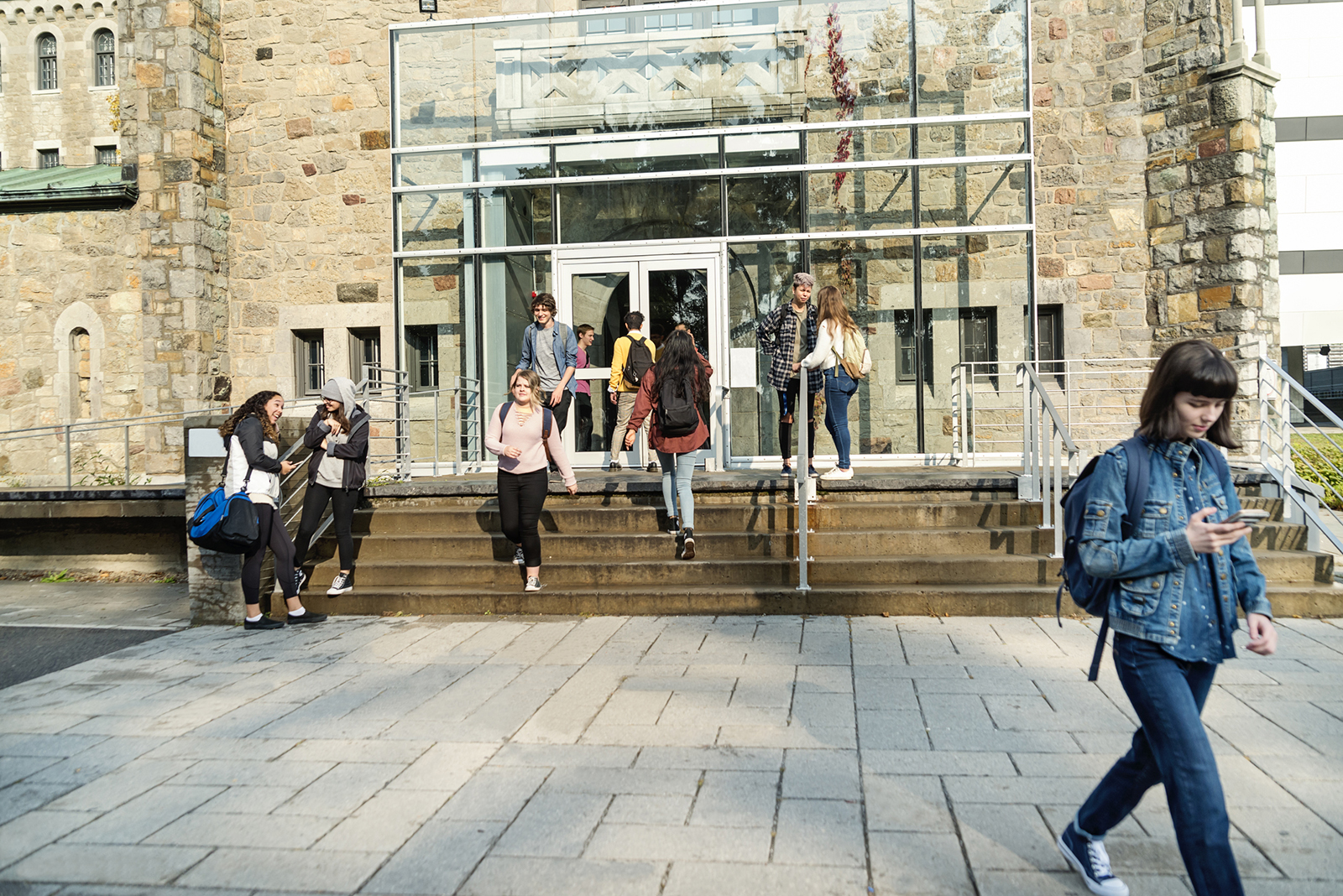
Dakota County, MinnesotaCase Study Interviewee(s): Michael Berndt, President, Inver Hills Community College and Dakota County Technical College; Mark Jacobs, Workforce Development Director, Dakota County and Director, Dakota-Scott Workforce Development Board; Jill Pittelkow, Program Supervisor, Employment and Economic Assistance Department, Dakota County County Landscape
About Dakota County, Minn.Dakota County, Minn. is situated in the southeast corner of the Twin Cities Metropolitan area and is the third-most populous county in the state of Minnesota. Dakota County has a land use mixture of one-third urban, one-third suburban and one-third rural. The county indicates that “this combination of land use and the confluence of two major rivers (the Mississippi and Minnesota) that form the county's northern and eastern borders makes Dakota County a unique geographic area.” [i] Dakota County is also home to several community colleges in the regional area. The county role in post-secondary educationIn Dakota County, most decisions involving public post-secondary education institutions and their programming are made through higher education boards and in collaboration with local workforce boards, secondary institutions and the county’s human services agency. Together, these partners focus on initiatives that work to expand career readiness and employment opportunities for residents. Dakota County’s Board of Commissioners has seven elected members and operates under Dillon’s Rule, which limits the county’s decision-making authority and abilities. Thus, local action must involve the Minnesota state legislature, which places restrictions on the county as legislative matters are voted on in biennial sessions.[ii]
Funding for post-secondary education institutions and programmingThe county’s public post-secondary education institutions are primarily supported by student tuition and state funding as approved by the state legislature. Despite its limited decision-making authority in post-secondary education, the Dakota County Board of Commissioners worked with community college leaders to expand residents’ access to local higher education institutions by funding a public transportation expansion effort. Recognizing the need to improve east-west connections and address mobility gaps and barriers, Dakota County Technical College (DCTC), Inver Hills Community College (Inver Hills) and county elected leaders came together to review Minnesota Valley Transit Authority (MVTA) ridership data and findings from student surveys regarding preferred public transit options to and from campus. While MVTA is a statewide public transportation system, county leaders leveraged this partnership to share data and use MVTA’s expertise to help inform the county in making decisions on a potential transportation expansion. In 2020, the county Board of Commissioners allocated “seed money” to fund the initial phases of the transportation capital improvement project that expanded bus routes and services within several communities leading to the colleges.[iii] They also set aside funds for transit service expansion and operating costs as a part of Dakota County’s transportation priorities in accordance with its comprehensive plan.[iv] In addition to its public investments, Dakota County received a grant from the Kresge Foundation to bring together higher education and human services agencies to create an ecosystem of service and supports for county residents to achieve economic mobility. Coordination and collaboration for improved workforce outcomesTo increase enrollment in post-secondary education institutions and provide students with a variety of higher education offerings in the county, secondary education systems partner with DCTC, Inver Hills and other institutions to host campus tours and showcase programs to high schoolers. DCTC and Inver Hills are the primary public colleges educating residents in Dakota County. DCTC is a public, two-year technical college that is located in Rosemount, Minnesota, and sits inside of the Minneapolis/St. Paul metropolitan area. The college is also part of the Minnesota State Colleges and Universities System and one of five stand-alone technical colleges in the state. The majority of DCTC students work toward degrees and diplomas in a variety of programs to prepare them for employment or transfer to a four-year university of college.[v] Inver Hills is a public community college in Inver Grove Heights, Minnesota and a part of the Minnesota State Colleges and Universities System. The majority of Inver Hills students also work toward degrees and diplomas in a variety of programs to prepare them for transfer or employment.[vi]
Dakota County’s 2020 Board Priorities and Strategic Plan Goals outline a vision for Dakota County and provide strategic direction and context for the work of county government. One of its strategic goals includes having a successful place for businesses and jobs. This includes fostering business and employment success through modern infrastructure, low taxes and a prepared, connected workforce. [vii] In support of these goals, DCTC and Inver Hills collaborate with local chambers of commerce to engage businesses in its career readiness efforts. Additionally, the colleges work with the Dakota County jail and the Minnesota Department of Corrections to provide outreach to incarcerated adults. Community college, local workforce development and human services leaders convene regularly to collaborate on ways to improve and expand higher education programs and training for strengthening the skillsets needed for employment in high-demand industries in the county. Dakota County is working to expand short-term training opportunities for low-income residents and other job seekers, changing the mindset from “having a job” to obtaining a sustaining career that transitions them from welfare to work. Minnesota’s one-stop career center, CareerForce, is a collaborative group of private for-profit, public and non-profit partners offering a range of innovative services. With 50 locations throughout the state, CareerForce provides one-on-one guidance, training, networking and labor market information for job seekers and works with employers on talent recruitment and retention plans.[viii] Dakota-Scott CareerForce has three locations providing these services to county residents. CareerForce works with about 1,000 low-income residents in Dakota County who are engaged in Minnesota’s Family Investment Program’s Temporary Assistance for Needy Families and Supplemental Nutrition Assistance Program (SNAP) and dislocated worker program for adults seeking employment and training services.[ix] The county also works closely with the Minnesota Department of Human Services to coordinate local workforce development activities with those of the state. Due to high unemployment rates as a result of the coronavirus (COVID-19), the county has experienced an increase in referrals for employment services and training programs at community colleges. Slowing the spread of COVID-19 in post-secondary education settingsTo help slow the spread of COVID-19, several post-secondary education institutions in the county are conducting online courses and using a hybrid model to minimize the number of students on campus. The county reports that about 95 percent of its courses at Inver Hills Community College are being held online and it is restricting on-campus courses in science labs and programming that requires hands-on training, such as nursing and other medical services. At DCTC, about 40 percent of its courses are being held on-campus because they mostly require hands-on technical training. To mitigate challenges with COVID-19, DCTC is reducing classroom sizes, requiring mask use, conducting student questionnaires, taking students’ temperature and monitoring positive COVID-19 cases to determine whether to shift on-campus courses to online. Moreover, DCTC holds regular calls with state and county public health officials to receive regular updates on COVID-19. To alleviate COVID-19 related costs, DCTC and Inver Hills received approximately $3 million in the Coronavirus Aid, Relief, and Economic Security Act funding, which was allocated by the state. During COVID-19, DCTC and Inver Hills partnered with Open Door, a local foodbank, to connect students experiencing food insecurity with mobile pantry services on their campuses and are exploring ways to increase students’ access to other social services in the county. During this time, Dakota County’s Employment and Economic Assistance Department is also providing outreach to residents enrolled in the SNAP program to participate in job fairs as a result of the increasing unemployment rates. ConclusionDCTC and Inver Hills serve as key post-secondary education institutions in Dakota County. While Dillon’s Rule limits Dakota County’s decision-making authority on post-secondary education systems, the county Board of Commissioners invested in a major transportation project that expands student access to local community and technical colleges. DCTC and Inver Hills actively partner with community services and workforce development agencies to expand career readiness opportunities for residents. While most courses at these institutions require hands-on training, the colleges are using precautionary measures to help slow the spread of COVID-19. [i] Dakota County. (2020, July 31). About Us. https://www.co.dakota.mn.us/About/Pages/default.aspx [ii] National League of Cities. (2016, December 13). Cities 101 — Delegation of Power. https://www.nlc.org/resource/cities-101-delegation-of-power [iii] Dakota County. (2020). Capital Improvement Program, 2020-2024. https://www.co.dakota.mn.us/Government/BudgetFinance/2020/Documents/2020-2024CapitalImprovementProgram.pdf [iv] Dakota County. (2019, June 18). Dakota County, Minnesota Comprehensive Plan. https://www.co.dakota.mn.us/Government/Planning/CompPlan/Documents/DakotaCounty2040ComprehensivePlan.pdf [v] Dakota County Technical College. (n.d.). About the College. https://www.dctc.edu/about-us [vi] Inver Hills Community College. (n.d.). About Inver Hills. https://www.inverhills.edu/about/index.aspx [vii] Dakota County. (2020, August 18). Strategic Plan Goals. https://www.co.dakota.mn.us/Government/Analysis/StrategicPlan/Pages/default.aspx [viii] CareerForce. (n.d.). About Us. https://www.careerforcemn.com/about-us [ix] Dakota County. (2020, July 8). Dislocated Worker Programs. https://www.co.dakota.mn.us/HealthFamily/FindJob/DislocatedWorkerPrograms/Pages/default.aspx |
||||
|
Erie County, Pa. |

Erie County, PennsylvaniaCase Study Interviewee(s): Charlotte Berringer, Director, Community Health Services, Erie County Department of Health; Kathy Dahlkemper, County Executive, Erie County; Gary Lee, Director of Administration, Erie County; Andrew Miller, Manager of Adult Services, Erie County Public Library County Landscape
About Erie County, Pa.Erie County, Pa. is a midsize county that is home to the Presque Isle Downs and Casino and a bustling retail corridor. The county is also a large manufacturing hub for the plastic, welding and automotive industries and is home to several industrial equipment supplier companies and small businesses. There are also several major universities and community colleges in the county that educate residents and prepare them for growing industries. The county role in post-secondary educationThe Erie County Council is a seven-member body of elected officials who allocate funding for county-based services as mandated by Commonwealth law. The County Council is responsible for passing the county budget, which in FY2020 was about $455 million.[i] Councilmembers serve as liaisons to county government agencies and the public. County residents also elect a County Executive, who oversees the administration of county departments and works with stakeholders to promote economic development in the county.[ii] Erie County has four major universities – Edinboro University of Pennsylvania, Gannon University, Mercyhurst University and Penn State Behrend – as well as Lake Erie College of Osteopathic Medicine, the largest medical college in the country.[iii] Recognizing the benefits of having more affordable options for higher education and skills-based training programs for residents, County Executive Kathy Dahlkemper and the County Council spearheaded the process of establishing a local community college for the county. In June 2017, the county sponsored the application for establishing the Erie County Community College (ECCC). From 2017 to 2020, the County Council held public hearings to hear recommendations from experts and the general public and gathered information from counties within and outside of the state to help inform the process for establishing ECCC. Erie County then created the ECCC Committee to provide guidance and advance the application to the Pennsylvania State Board of Education. The ECCC Committee was comprised of members of Erie County Council and the County Executive’s administration, as well as a representative of a local non-profit and a financial consultant. The ECCC Committee led state and community engagement efforts, which helped the county gain approval of the ECCC plan from the Pennsylvania State Board of Education in July 2020. In August 2020, Erie County Council selected ECCC’s full board of trustees, which has decision making authority over college operations and programming and informs the initial phases of planning.[iv] Funding for post-secondary education institutions and programmingThe planning and formation of ECCC is supported by local funding. Erie County government will be providing a local match as ECCC’s startup fund to support planning activities for establishing the college. The projected startup funds will include about $10 million from the Redevelopment Authority Capital Program, a statewide grant program that supports the construction of regional economic, cultural or historical improvement projects.[v] Approximately $7 million of the county’s match is projected to come from the Erie County gaming revenue funds, and $3 million from the Erie Community Foundation. The county is not dictating how ECCC spends the funding, however, ECCC is charged with developing a budget to determine projected needs and costs. This includes plans to educate approximately 500 equivalent full-time students and prioritize programs and majors that ECCC can offer in the first years.
Coordination and collaboration for improved workforce outcomesErie County coordinates with community partners to support residents seeking workforce and post-secondary education opportunities. Since 2010, partners, including county government and post-secondary education institutions, have led a countywide initiative called Erie Together. Erie Together offers programming that provides youth engagement, career building services and connections to post-secondary education, including Erie County Career Pathways Alliance, a countywide system that aligns high school coursework with post-secondary education. The program also prepares youth for careers in the local workforce and supports their efforts in continuing their education. The program is supported by school districts, unions, manufacturing groups and post-secondary education institutions in the county.[vi] Once fully established, the county anticipates that ECCC will also be a key partner in this initiative. Erie Together also operates Career Street, a program that works with businesses, non-profit organizations, county government and K-12 schools in creating opportunities for students to intern, tour companies and shadow professionals, hear from job readiness and placement experts and participate in career workshops and fairs. The program engages employers to ensure that these opportunities are preparing students of all ages for local jobs. In partnership with the Erie County Gaming Revenue Authority and the Erie Community Foundation, Erie County’s government provides funding for the Summer Jobs and More (JAM) program, which creates employment and career preparedness opportunities for young adults. Through JAM, program participants ages 16 to 21 gain new skills from on-the-job training experiences and apply them while working in local industry jobs. This sparks students’ interests in obtaining higher education and/or the necessary training for future careers. Since 2014, the JAM program has received approximately $2.215 million and served over 1,000 youth in the county. In 2019, the program reported an 88% success rate.[vii] Through the Erie County Public Library system, Erie County government is supporting residents interested in pursuing entrepreneurship or starting a small business. The library system partners with four post-secondary education institutions in the county to serve as an accelerator for business expansion and development by providing hands-on learning experiences and classes for beginning entrepreneurs. Known as the NWPA Innovation Beehive Network, the program gives residents access to and support in learning cross-cutting technologies.[viii] Recognizing limitations in broadband access, the library system also offers five spaces across the county for residents to access WiFi and public computers.
Erie County coordinates with neighboring communities to develop and leverage regional partnerships that increase career readiness opportunities for residents. Erie County is one of six counties served by Northwest Pennsylvania Job Connect (NWPA Job Connect), a Workforce Development Board (WDB). County Executive Dahlkemper serves as a “chief local elected official” for the WDB where she appoints members and approves NWPA Job Connect’s budget and local and regional plans.[ix] NWPA Job Connect, which has a dedicated position serving on Erie Together’s leadership team, works with residents and employers to ensure county residents are prepared for careers in the local economy. NWPA Job Connect also manages Northwest PA CareerLink, which is a collaborative workforce development system that connects and coordinates partner agencies across the six counties. Through two one-stop career centers, CareerLink connects jobseekers to employers, resources, training and post-secondary and adult education opportunities.[x] The program also operates a mobile model that delivers services and resources to sites such as community centers and libraries, allowing jobseekers to access CareerLink in these spaces instead of visiting the career centers. The flexibility of the mobile model helps increase service access during the coronavirus (COVID-19). Slowing the spread of COVID-19 in post-secondary education settingsThe Erie County Department of Health (ECDH) is working closely with post-secondary education institutions by providing guidance on public health precautions for slowing the spread of COVID-19. During the summer of 2020, ECDH held regular calls with higher education institution leaders to offer guidance from the state Department of Health and the Centers for Disease Control and Prevention (CDC). Moreover, many colleges and universities in the county have pandemic coordinators, who support students’ health and other needs during COVID-19. Several post-secondary education institutions in the county are using a hybrid approach, with students attending classes both in-person and online. Trade schools, whose programs often require hands on skills-based training for fields such as manufacturing, healthcare and hospitality, remain primarily in-person. These programs are implementing social distancing standards, reducing class sizes and requiring mask use. Post-secondary education institutions are also shifting semester schedules to minimize student travel and allow more time for quarantining before returning to campus. One Erie County post-secondary education institution is using an innovative technology application for students, faculty and employees to monitor and report any COVID-19 symptoms. ConclusionRecognizing the need for affordable post-secondary education options in the county, Erie County took a bold step by establishing and funding a local community college. The county also brings public and private partners to the decision-making table to connect youth and disconnected residents to workforce development programs, training and education. Throughout the pandemic, the county has worked in partnership with local post-secondary education institutions to guide the COVID-19 response and ensure students are fully supported by county resources. [i] Erie County, Pennsylvania. (n.d.). County Council. https://eriecountypa.gov/departments/county-council/ [ii] Erie County, Pennsylvania. (n.d.). County Executive’s Office. https://eriecountypa.gov/departments/county-executives-office [iii] Erie County, Pennsylvania. (n.d.). Living in Erie County. https://eriecountypa.gov/about/about-erie-county/living-in-erie-county/ [iv] Erie County, Pennsylvania. (n.d.). Community College. https://eriecountypa.gov/departments/county-executives-office/initiatives/ community-college/ [v] Erie County Redevelopment Authority. (n.d.). Grant Services. https://ecrda.net/grants.php [vi] Erie Together. (n.d.). Erie County Career Pathways Alliance. https://www.erietogether.org/erie-county-career-pathways-alliance [vii] Greater Erie Community Action Committee. (n.d.). Summer JAM. https://www.gecac.org/work/employment-and-income/summer-jam [viii] NWPA Innovation Beehive Network. (n.d.) Who We Are. https://www.nwpabeehive.com/ [ix] NWPA Job Connect. (n.d.). Chief Local Elected Officials. https://www.nwpajobconnect.org/lwda-chief-local-elected-officials
[x] NWPA Job Connect. (n.d.). Northwest PA CareerLink®. https://www.nwpajobconnect.org/careerlink
|
||||
|
Wake County, N.C. |

Wake County, North CarolinaCase Study Interviewee(s): Johnna Sharpe, Chief Operating Officer, Wake County and Katherine Williams, County Extension Director, Wake County Center, NC Cooperative Extension County Landscape
About Wake County, N.C.Wake County, North Carolina is a large, fast-growing mostly urban area and the state’s second most populous county. The Research Triangle Park (RTP), located between Durham and Raleigh, heavily influences the county’s economy. The RTP is one of the nation’s largest planned research development communities and a major center for technology and textile development. [i] Key industries include biotechnology, pharmaceuticals, medical technologies and research, software and information technology development and defense technologies. The county role in post-secondary educationWake County is governed by a seven-member Board of Commissioners, which enacts policies regarding local property tax rate, land use and zoning regulations affecting municipal jurisdictions. Board members also adopt the annual budget, which in fiscal year 2021 was $1.47 billion. [ii] The board appoints the County Manager, who leads county departments and agencies and maintains relationships with elected and appointed officials. Wake County’s institutions of higher learning include Meredith College, Campbell University, North Carolina Central University, William Peace University, Saint Augustine's College, Shaw University, Southeastern Baptist Theological Seminary, North Carolina State University and Wake Technical Community College (WTCC).[iii] Although Wake County has limited decision-making authority in post-secondary education, county government works closely with WTCC to make decisions about workforce and post-secondary education opportunities for county residents. As part of her effort to ensure that the county is operating efficiently and effectively, the county’s Chief Operating Officer Johnna Sharpe serves as the liaison between county government and WTCC. Local leaders inform the county’s service delivery system and workforce development programs based on data-driven strategies. For instance, the county government maintains a Transparency Portal designed to make data accessible to stakeholders to inform decision-making.[iv] The portal is accessible to the general public and includes data on topics such as demographics, education, public safety and transportation. It also includes geographic data and information for mapping and analysis. Recently, WTCC used this data to select the location of its new satellite campus and prioritize low-income communities to make education and other services accessible for residents in need.
Funding for post-secondary education institutions and programmingNorth Carolina state statute authorizes its counties to fund community colleges’ costs for facilities, construction and ongoing maintenance.[v] In the last few years, Wake County has increased its funding allocations to WTCC, prioritizing investments in technological equipment and infrastructure. On November 2, 2018, local voters approved a $349 million, four-year bond package for capital investments including new campuses, facility repairs and renovations, and technology equipment and infrastructure improvements. WTCC’s Health Science building was one of several projects funded in FY2019 to be supported by the bond. This bond gives Wake County commissioners the authority to raise the property tax rate for a designated purchase, which “includes a 1.15 cent increase to fund four years worth of construction, security and technology needs for the state’s largest community college.”[vi] In addition to the multi-year capital improvement program, the county’s FY2021 recurring annual appropriation to support WTCC’s operational expenses and staffing was $24.75 million.[vii] Coordination and collaboration for improved workforce outcomesWake County government collaborates with its state universities and WTCC to address priorities affecting local residents. North Carolina State University and North Carolina A&T State University jointly operate the N.C. Cooperative Extension program, which has local offices in every county working to enhance the community’s education and connection to research. Extension offices are jointly funded by the U.S. Department of Agriculture, the state land-grant universities and county government.
Wake County Human Services (WCHS) partners with the N.C. Cooperative Extension-Wake County Center to support Wake County Board of Commissioners’ strategic initiative goals involving Social and Economic Vitality (SEV). These goals focus on community revitalization and work to amplify community voice, support community wellness and educational advancement and expand economic opportunities to reduce poverty in the county.[viii] The SEV initiative refers residents in need to social services to help meet their basic needs. It also connects residents to workforce and educational opportunities through WTCC programming and other organizations. Through the SEV initiative and to address equity issues, WCHS and WTCC share student-level data to identify low-income students experiencing financial hardship and develop strategies to strengthen their connection to county-based human services. Additionally, N.C. Cooperative Extension-Wake County operates the Empowering Entrepreneurs And Seeding Innovation (EEASI) Challenge, which is a transformational cohort learning experience that teaches entrepreneurship to primarily high schoolers as an essential life skill – equipping youth and adults for financial, personal and professional success. The EEASI Challenge is funded in part by the City of Raleigh, Wake County and WTCC. [ix] Priority consideration is given to residents living in zip codes presenting the highest economic disparities. Wake County government and WTCC collaborate to promote economic mobility among residents through workforce development opportunities. In January 2020, WTCC and the county created WakeWorks, a program at WTCC that connects residents to apprenticeships, local employers and scholarships in receiving continuing education. Through WakeWorks Apprenticeships, WTCC students gain on-the-job experience and classroom instruction in fields with higher paying, in-demand jobs. Current apprenticeship programs include skilled trades such as HVAC technician involving heating, ventilation, and air conditioning technology for indoor and vehicular environmental comfort and automotive mechanics with additional programs in apartment maintenance, building and code inspection, masonry and plumbing.[x] Through WakeWorks Propel, WTCC offers scholarships in select fields to incentivize students pursuing in-demand professions such as information technology, skilled construction and maintenance, public safety, healthcare and manufacturing.
Students in both WakeWorks programs receive guidance and support from WTCC career coaches and the Capital Area Workforce Development Board.[xi] In addition to championing the creation of the program, the Board of Commissioners unanimously approved $500,000 in funding for WakeWorks to provide students with tuition assistance, books and uniforms, with WTCC covering $300,000 in start-up costs for the program and a marketing campaign.[xii] Slowing the spread of COVID-19 in postsecondary education settingsThrough the Coronavirus Aid, Relief, and Economic Security (CARES) Act, WTCC received both federal and local relief funds to facilitate online and remote learning and help meet students’ basic needs. The county government also allocated relief funds to workforce development efforts, purchasing robotics training equipment and other programmatic resources to sustain workforce development and employment services and activities during and after the pandemic. ConclusionWake County leverages its community college as well as the county’s land-grant university extension offices to meet the educational and training needs of residents and increase their skill set for job markets that strengthen the local economy. Through cross-sector initiatives like WakeWorks and SEV, the county connects residents to services to help meet their basic needs, especially for low-income residents experiencing financial hardship. Collaboration among public and private sectors involve data and information sharing to remove educational barriers and create pathways for residents in obtaining well-compensated jobs in high-demand industries in the county. Wake County has also leveraged federal and local funding to ensure students and residents remain supported through the global pandemic. [i] Wake County. (n.d.). About Wake County. http://www.wakegov.com/about/facts/Pages/default.aspx [ii] Wake County. (n.d.). Board of Commissioners. http://www.wakegov.com/commissioners/Pages/default.aspx [iii] Wake County Economic Development. (2021). Education: 4-Year Colleges and Universities. https://raleigh-wake.org/living-in-wake/education/4-year-colleges-and-universities [iv] Wake County. (2021). Transparency Portal. https://www.wakegov.com/transparency-portal [v] Quinterno, J. (2019, March 14). How the ‘open doors’ stay open: Funding North Carolina’s community colleges. North Carolina Center for Public Policy Research. https://nccppr.org/how-the-open-doors-stay-open-funding-north-carolinas-community-colleges [vi] Johnson, A. (2018, October 29). Here’s what you need to know about the $349 million bond for Wake Tech. The News & Observer. https://www.newsobserver.com/news/local/article220440705.html [vii] Wake County. (2020, June 15). Adopted Operating Budget and Capital Improvement Program. https://www.wakegov.com/departments-government/budget-management-services/current-year-budget-resources [viii] Farmer, A. (2020, May). Social and Economic Vitality. NC Cooperative Extension. https://wake.ces.ncsu.edu/social-and-economic-vitality/ [ix] Farmer, A. (2020, August). Empowering Entrepreneurs and Seeding Innovation Challenge. NC Cooperative Extension. https://wake.ces.ncsu.edu/social-and-economic-vitality/empowering-entrepreneurs-and-seeding-innovation-challenge/ [x] Wake Tech Community College. (n.d.). WakeWorks© Apprenticeship. https://www.waketech.edu/programs-courses/wakeworks/apprenticeship [xi] Wake Tech Community College. WakeWorks© Propel. https://www.waketech.edu/programs-courses/wakeworks/propel [xii] Tauss, L. (2020, January 28). A New Partnership Between Wake County and Wake Tech Aims to Help People Climb the Economic Ladder. Indy Week. https://indyweek.com/news/wake/wake-county-wake-tech-wake-works/ |
||||
|
Allegheny County, Pa. |

Allegheny County, PennsylvaniaCase Study Interviewee(s): Dr. Quintin B. Bullock, President, Community College of Allegheny County; Erin Dalton, Deputy Director, Allegheny County Department of Human Services; Abigail Horn, Deputy Director, Office of Community Services, Allegheny County Department of Human Services; Jennifer Liptak, Chief of Staff, County Executive Rich Fitzgerald County Landscape
About Allegheny County, Pa.Allegheny County, Pa., home to the city of Pittsburgh, is the state’s second most populous county. Allegheny County’s major industries include advanced manufacturing, healthcare and financial and business services. The county is also home to several headquarters of Fortune 500 corporations, including U.S. Steel Corporation, PNC Financial Services Group, PPG Industries, and H. J. Heinz Company. It is also home to several major colleges and universities such as Carlow University, Chatham University, LaRoche College, Penn State Greater Allegheny and the University of Pittsburgh and community colleges and technical institutions such as the Community College of Allegheny County (CCAC), Empire Beauty Schools, Institute of Medical and Business Careers, Pittsburg Career Institute and Institutes of Aeronautics and Mortuary Science and Vet Tech Institute.
The county role in post-secondary educationAllegheny County Council serves as the county government’s legislative branch and includes fifteen elected officials.[i] On January 1, 2000, the Home-Rule Charter went into effect. Primary powers and duties of the council involve approving and amending legislation submitted by either the County Executive or a Council member, permitting use of county land, levying taxes and fees, confirming or rejecting appointments for county agencies and authorities and annually adopting a balanced county budget, which in FY2020 was $959.8 million.[ii] Allegheny County residents also elect a County Executive who provides leadership and strategic direction and ensures that policy is implemented effectively and efficiently.[iii] Allegheny County’s government leaders engage local stakeholders and work in collaboration with CCAC to create career readiness pathways and increase educational opportunities for residents. While county government leaders work closely with CCAC to allocate resources in supporting college operations, instruction and workforce training opportunities for students, they do not have direct decision-making authority in matters involving CCAC and other post-secondary education systems in the county. However, Allegheny County’s Executive and County Council nominate and confirm CCAC’s Board of Trustees. The county board approves CCAC’s budget and works closely with CCAC president Dr. Quintin B. Bullock and his team to develop policies for operations and educational programming.[iv] Funding for post-secondary education institutions and programmingIn addition to appointing the Board of Trustees, Allegheny County’s government shows commitment to CCAC by providing a local funding match, which supports both operation and capital funds. In its 2020 budget, Allegheny County allocated $800,000 for capital costs to the college and $26,695,977 for operating costs.[v] Allegheny County is the second largest source of government appropriations for CCAC, second to the Commonwealth of Pennsylvania.[vi] CCAC submits its financials to the county each year to include them in the county’s comprehensive annual financial report.
Coordination and collaboration for improved workforce outcomesAllegheny County’s community, government and post-secondary education leaders share data and information and regularly convene to discuss approaches for connecting residents to educational and employment opportunities. Partner4Work leads county and citywide coordination on workforce readiness programming and activities. Partner4Work is a non-governmental organization that connects adult and youth jobseekers in Allegheny County and the city of Pittsburgh with businesses and employers and links them to job readiness supports.[vii] Partner4Work’s Board of Directors and various advisory boards convene local stakeholders to support collaboration among higher education and public and private sector partners on career readiness activities. The Board of Directors is primarily comprised of business leaders, but also includes CCAC staff and members of state, county and city government, as well as representatives from unions and non-profit and community-based organizations. Standing committees discuss and develop approaches for expanding educational and employment opportunities for certain populations, such as youth ages 14-21 and older adults. [viii] Allegheny County’s Department of Human Services (ACDHS) and Partner4Work co-lead the Learn & Earn Summer Youth Employment Program, a community-wide effort to help low-income youth and young adults gain the skills and experience necessary in becoming successful members of the region’s workforce. Since 2015, Learn & Earn connected nearly 6,000 young people with jobs across 400 worksites and returned more than $6 million in wages to the local economy.[ix] Other youth programming supports young adults as they complete high school, earn a General Educational Development certificate or prepare for post-secondary education or credential programs.[x]
Allegheny County connects residents to vital county-based social services and supports to reduce systemic barriers for residents seeking and obtaining a higher education degree, credential or training and employment. In 2018, about 52 percent of ACDHS clients were disconnected from the labor force.[xi] These groups also face challenges with housing and unemployment. Thus, ACDHS provides interventions for increasing clients’ participation in higher education while connecting them to services that help meet their basic needs such as housing, access to food and transportation and other social supports. To better serve families and children, ACDHS is utilizing a holistic, two-generation approach that simultaneously addresses parents’ and children’s needs. Parents engaged in higher education and employment are connected to the county’s family centers, which provide support and education on child development and parent-child relationships.
ACDHS partners with CCAC to remove barriers to education by connecting students to wrap-around comprehensive services and supports that are co-located on campus grounds. Through the partnership, CCAC offers Resource Navigators, who support students in navigating systems that connect them to community resources, such as child care, housing, mental health services and more. Since the program’s creation, navigators have referred over 700 students to ACDHS and other community resources.[xii] ACDHS trains navigators so they are knowledgeable about the social services available in the county and service delivery practices. ACDHS and CCAC collaborated on developing the program’s design and jointly apply for grant funding. CCAC also offers a Pathways to Success in Healthcare Grant to provide county residents interested in a career in the healthcare field with financial assistance. Grant recipients are connected with wrap-around services to address academic, financial and personal issues that often become barriers to educational attainment. This includes assistance with child care, housing and transportation.[xiii] Slowing the spread of COVID-19 in post-secondary education settingsDuring the coronavirus (COVID-19) pandemic, the Pittsburgh Council on Higher Education (PCHE), a voluntary consortium of ten post-secondary education institutions in the county, is serving as a resource for slowing the spread of COVID-19.[xiv] Through PCHE, the county’s post-secondary education institutions share information and coordinate their reopening plans. The Allegheny County Health Department is advising institutions on COVID-19 testing, contact tracing, social distancing and reporting COVID-19 cases. In addition to state and local funds, post-secondary education institutions received direct federal funding through the Coronavirus, Aid, Relief and Economic Security Act to support student aid and institutional costs. CCAC received $3,993,740 to provide emergency financial aid grants to students experiencing financial hardship and $3,993,739 to cover institutional costs resulting from changes to instruction delivery due to COVID-19.[xv] In Pennsylvania, post-secondary education institutions can also use Governor’s Emergency Education Relief funds for COVID-19 related expenses such as personal protective equipment (PPE), sanitizing and cleaning products, technology for online instruction or health applications to assist with contact tracing.[xvi] The county also distributed funds, on a per capita basis, to PCHE institutions to assist with reimbursement for PPE and other needs arising from the pandemic.
During the pandemic, CCAC increased its online course offerings, with online enrollment up by 25 percent. CCAC also offers financial emergency assistance for students experiencing an unexpected emergency or an economic hardship. CCAC’s Resource Navigators, on-campus food pantries, and clothes closet support students presenting barriers in meeting basic needs. Students also receive public assistance and other supports. ConclusionAllegheny County leaders view CCAC and other local post-secondary education institutions as a community asset and continue to provide funding and collaborate on career readiness efforts. County and regional efforts, led by Partner4Work and ACDHS, have helped the county improve the educational and employment outcomes of residents experiencing economic hardship through service navigators and on-campus resources and by addressing the local workforce needs of the community. Post-secondary education institutions coordinate with one another and with county-based social service agencies to help meet students’ basic needs and support them during the COVID-19 pandemic. [i] Allegheny County. (n.d.). Your County. Your Government. https://www.alleghenycounty.us/ [ii] Martines, J. (2019, December 3). Allegheny County’s $1B budget includes no tax increase. Trib Live. https://triblive.com/local/pittsburgh-allegheny/allegheny-county-council-approves-2020-budget [iii] Allegheny County. (n.d.). Office of the County Executive. https://www.alleghenycounty.us/county-executive/mission.aspx [iv] Community College of Allegheny County. (n.d.). Board of Trustees. https://www.ccac.edu/president/board-of-trustees/index.php [v] Allegheny County. (n.d.). County Budgets. https://www.alleghenycounty.us/budget-finance/county-budgets.aspx [vi] Community College of Allegheny County. (2019). #Success: 2018 Annual Report. https://www.ccac.edu/president/_files_ president/2018-annual-report_web.pdf [vii] Partner4Work. (n.d.). What is Partner4Work? https://www.partner4work.org/about/history/ [viii] Partner4Work. (2020, September 25). Board of Directors’ Briefing Book. https://www.partner4work.org/uploads/p4w-board-briefing-book-for-09-25-2020.pdf [ix] Partner4Work. (n.d.). Learn & Earn. https://www.partner4work.org/programs/learn-earn/ [x] Partner4Work. (n.d.). Young Adults Programs. https://www.partner4work.org/programs/young-adults-programs/ [xi] Allegheny County Department of Human Services. (2020, February 18). Labor Market Experiences of Allegheny County Department of Human Services Clients. https://www.alleghenycountyanalytics.us/index.php/2020/02/18/labor-market-experiences-of-allegheny-county-department-of-human-services-clients/ [xii] Community College of Allegheny County. (n.d.). Resource Navigators. https://www.ccac.edu/student-services/resource-navigators.php [xiii] Community College of Allegheny County. (n.d.). Pathway to Success in Healthcare Grant. https://www.ccac.edu/workforce/hpog.php [xiv] Pittsburgh Council on Higher Education. (n.d.). Home. https://pche-pa.org/ [xv] Community College of Allegheny County. (2020, August). Year-End Report. https://www.ccac.edu/president/_files_president/year-end-report-aug2020.pdf [xvi] Pennsylvania Department of Education. (n.d.). Governor’s Emergency Education Relief (GEER) Funds. https://www.education.pa.gov/Schools/safeschools/emergencyplanning/COVID-19/GEER/Pages/default.aspx |
||||
|
Montgomery County, Ohio |

Montgomery County, OhioCase Study Interviewee(s): Kelly Geers, Director of Strategic Initiatives, Montgomery County; Deborah Lieberman, County Commissioner, Montgomery County; John Theobald, Commission Assistant, Montgomery County County Landscape
About Montgomery County, OhioLocated in the southwestern region of Ohio, Montgomery County spans over 460 square miles and maintains a labor force of more than 250,000 individuals. In 2018, the county’s economic output was nearly $26 billion with the top industries being education, health care and social assistance services, real estate, rental and leasing and manufacturing.[i] The county also has a booming automotive industry. The county role in post-secondary educationMontgomery County’s Board of Commissioners has three elected officials who vote on resolutions regarding county business covering a variety of local policy issues and budget and administrative matters.[ii] Montgomery County’s largest post-secondary education institution, Sinclair Community College, is governed by an eleven-member board of trustees that are appointed for five-year terms and have governing authority over the entire operations of the college.[iii] Montgomery County is a statutory county that operates under the Ohio Revised Code and has minimal decision-making authority affecting its post-secondary education institutions within the county. However, county board members have the authority to appoint six members to the community college board.[iv] Funding for post-secondary education institutions and programmingIn addition to receiving state funding, Ohio’s post-secondary education institutions also have the authority to leverage local dollars to manage operations, departmental functions and educational programs. For instance, Sinclair Community College leverages county tax levies which provide funds for daily operations and support for student tuition, making the college one of the most affordable institutions in the region for residents.[v] The county also approves the inclusion of the levies for local community colleges on the ballot and supports marketing efforts to help boost student enrollment. In addition to endorsing these levies, the county occasionally provides funding for specific programs and initiatives related to its local colleges.
Coordination and collaboration for improved workforce outcomesMontgomery County fosters collaboration between its post-secondary education institutions, local workforce resource centers and human services mainly through its local workforce development board. The Greater Ohio Workforce Board (GOWB) creates workforce resources and employment opportunities for Ohio’s businesses and job seekers across 44 counties.[vi] Both the local workforce board and the GOWB manage programs that assist employers in meeting their hiring needs and connect workers to suitable jobs.[vii] The county leverages federal, state, regional and local partnerships to provide workforce training programs, post-secondary education credentials and social services to its residents. Funded in part by the Workforce Innovation and Opportunity Act (WIOA), the Montgomery County Jobs Center, which houses over forty organizations, is considered to be the largest employment and training center in the United States. The Jobs Center brings together employers, educators, social service agencies and Sinclair Community College to jointly determine service needs and promote diverse programming for the center’s workforce development training.[viii] This creates a local workforce development system that benefits both employers and job seekers.[ix] Montgomery County’s OhioMeansJobs provides a central place for employers to access a pool of qualified, job-ready workers. In addition, job seekers can access job information, training programs and other services needed for employment and career development.
In collaboration with GOWB, Montgomery County is investing over $2 million into a new Employment Opportunity Center that will provide equitable job search help and training opportunities for residents. The center will house several workforce services including mentorship programs for young adults, a resource lab for resume and interview skill-building and the Miami Valley Career Technology Center’s (CTC) Aspire program, offering high school equivalency resources for service recipients. Miami Valley CTC is a public career technical school serving five southwestern Ohio counties. Miami Valley CTC provides adult learning in advanced manufacturing, such as avionics, precision machinery robotics and automation and welding, as well as agriculture, livestock production and natural resource management, diesel power technology, hospitality, early childhood education and culinary arts.[x] Additionally, the center will house staff that will administer job training grants from the federal WIOA. These grants can fund up to $15,000 for eligible individuals to obtain new skills by acquiring commercial driver’s licenses, nursing degrees and manufacturing and IT certifications.[xi] Montgomery County Development Services provides access to services that are targeted to meet the workforce-related needs of area employers, jobseekers and youth preparing to enter the world of work. Through Project Hire’s on-the-job training program, the county provides incumbent worker training, customized group training or individual training to promote an educated and well-prepared workforce.[xii] Montgomery County Development Services also offers a wealth of job seeker services, ranging from an online job search portal, special resources for laid off workers and networking opportunities. In Ohio, social service programs are state sponsored and county administered. Each county government has latitude to design programs, collect and allocate funds and target resources within the limits of state and federal regulations.[xiii] Montgomery County has a human services tax levy and in 2018, the local funding stream accounted for approximately $135 million in property taxes for health and human services. Because human services are county-administered in Ohio, its counties rely on locally generated funds to support the delivery of health and social services to a greater degree than most other states. The purpose and amount of funding for health and social services that comes from the county levy determines the type and level of services that may be available for residents.[xiv]
Montgomery County’s human services levy supports the county’s reentry initiative, which assists residents with a criminal record in gaining access to job seeking and employment services and workforce development training. The county reports high completion rates among men and women enrolled in the program. As a result of participating in this program, many participants are finding employment, even during the current economic crisis. In addition to workforce development services, the human services levy supports the county in providing substance abuse and mental health, housing and food access services. Slowing the spread of COVID-19 in post-secondary education settingsMontgomery County’s Health Department has worked tirelessly to collaborate with their post-secondary education institutions during the coronavirus (COVID-19) pandemic. The county declared a state of emergency and established a team to lead a coordinated response. Post-secondary education institutions have been active participants on calls with the county’s health commissioner in order to stay up to date on the developing situation. In response to COVID-19, the county allocated Coronavirus Aid, Relief, and Economic Security (CARES) Act funds to its primary and secondary education institutions but did not have the authority to distribute funding to its colleges and universities. Although the state allocated CARES Act funding directly to post-secondary education institutions, county leaders were able to provide guidance and personal protective equipment (PPE) to local post-secondary education institutions. Using the advice from the county health department, post-secondary education institutions determined the best strategies for slowing the spread of the virus on college campuses. ConclusionIn Ohio, due to the state’s authority in post-secondary education, higher education institutions tend to have a direct relationship with the state rather than local governments. However, Montgomery County’s local tax levy and strong partnership with its post-secondary education institutions through its workforce development board and human services agency allow the county to support local efforts increasing educational attainment and career readiness opportunities for residents. In response to COVID-19, the county is addressing health disparities on college and university campuses by increasing student’s access to health resources, PPE and other supports. [i] National Association of Counties. (2020). County Economies 2020. https://www.naco.org/resources/featured/county-economies-2020 [ii] Montgomery County. (n.d.). Board of County Commissioners. https://www.mcohio.org/government/elected_officials/board_of_ county_commissioners/index.php [iii] Sinclair College. (n.d.). Board of Trustees. https://www.sinclair.edu/about/board/ [iv] Montgomery County. (n.d). Montgomery County Boards and Commissions. https://www.mcohio.org/government/elected_officials/ board_of_county_commissioners/boards_commissions_details.cfm?id=42 [v] Sinclair College. (n.d.). Financial Resources. https://www.sinclair.edu/about/consumer-info/financial-resources/ [vi] Greater Ohio Workforce Board. (n.d). Greater Ohio Workforce Board https://gowbi.org/ [vii] Ohio Department of Job and Family Services. (n.d.). Governance and Oversight. https://jfs.ohio.gov/owd/wioa/Governance-Home.stm [viii] Montgomery County Business Services. (n.d.). About OhioMeansJobs. https://thejobcenter.org/about/ [ix] Dayton Area Chamber of Commerce. (n.d.). Montgomery County Development Services-Workforce Development. http:// daytonworkforce.com/montgomery-county-development-services-workforce-development/ [x] Miami Valley Career Technical Center. (n.d.). Career Technical Programs. http://www.mvctc.com/future-students/programs [xi] Montgomery County. (2020, October). Montgomery County kicks off $2 million workforce investment project in West Dayton. https://www.mcohio.org/news_detail_T6_R528.php [xii] Dayton Area Chamber of Commerce. (n.d.). Montgomery County Development Services-Workforce Development. http://daytonworkforce.com/montgomery-county-development-services-workforce-development/ [xiii] Campbell, E. (2019, November 25). Haves Nots County Property Taxes Provided $25 billion in Local Health and Social Services Funding Unevenly Distributed. The Center for Community Solutions. https://www.communitysolutions.com/research/haves-nots-county-property-taxes-provided-2-5-billion-local-health-social-service-funding-unevenly-distributed/ [xiv] Ibid. |
||||
|
Waukesha County, Wis. |

Waukesha County, WisconsinCase Study Interviewee(s): James M. Boling Jr., Youth and Family Educator, Extension Waukesha County 4-H Staff; Jerry Braatz, Extension Area Director, Extension Waukesha County; Paul Decker, Chairman, Waukesha County Board of Supervisors; Tom Michalski, Supervisor, Waukesha County and Board Member, Waukesha County Technical College County Landscape
About Waukesha County, Wis.Waukesha County, Wis. is a mid-sized county and the third largest county in Wisconsin. It neighbors Milwaukee County, Wis. and is located 15 miles west of the city of Milwaukee and 100 miles north of Chicago, Ill. Major industries include manufacturing, particularly food manufacturing services, and retail trade. The county has 21,000 acres of state, county and municipal public parks and is home to more than 77 lakes, offering residents and visitors a range of outdoor recreational and park services, including fishing, boating, hiking and camping.[i] The county role in post-secondary educationWaukesha County is governed by a 25-member Board of Supervisors, elected to two-year terms. The county board serves as the legislative branch of Waukesha County government and sets policy by adopting ordinances and resolutions. The board is responsible for adopting the county’s annual budget, which in 2020 was $106.2 million.[ii] Waukesha County residents also elect a County Executive, who serves a four-year term and is responsible for coordinating and directing administrative and management functions of the county.[iii] The county is home to a number of colleges and universities, including Carroll University and campuses of the University of Wisconsin and Ottawa University. Wisconsin has 16 state technical colleges, each of which serves a designated geographic district. Each technical college appoints a board, which makes policy decisions, levies property taxes for facilities and equipment, develops the annual budget and approves hiring decisions. Waukesha County, along with Jefferson, Dodge and Racine counties, is served by Waukesha County Technical College (WCTC). WCTC’s board members are appointed by the county board chairs from the four counties in its district. Because Waukesha County accounts for 95 percent of WCTC’s district, the chairperson of the Waukesha County Board serves as the district board appointment chair for WCTC.[iv] Funding for post-secondary education institutions and programmingWCTC is funded through a combination of state, local and private funds. The majority of WCTC’s funding is allocated in the state’s annual budget. WCTC also receives funding from local property taxes from the counties within its district. In 2018-2019, the tax was $2.11 per $1,000 of equalized value. County property tax is the third largest source of property tax revenue, after state and local.[v] Counties also provide funding for the University of Wisconsin (UW)-Madison Extension Offices across the state. UW’s land-grant extension offices operate research centers and offer educational programs to local residents. The Waukesha County UW-Madison Extension Office (Extension Waukesha County) offers programming on community and leadership development, agriculture and horticulture and nutrition and food resource management.[vi] In its 2020 budget, Waukesha County provided $348,763 to support the Extension Waukesha County office.[vii]
Coordination and collaboration for improved workforce outcomesThrough youth apprenticeship programs and the Dual Enrollment Academy, Waukesha County is creating career and post-secondary education pathways for youth while supplying businesses with well-trained talent. WCTC’s Dual Enrollment Academy allows students to earn college credits while enrolled in high school. The Academy’s programs support students in cultivating the skillsets needed for high-demand fields in the county, such as working with automation systems and obtaining careers in construction, early childhood education and welding.[viii] WCTC also operates a Youth Apprenticeship (YA) program for high school juniors and seniors that combines classroom education with paid work experience. Apprentices are paired with a workplace mentor and receive on-the-job training and a state-issued skills certificate. On average, 80 percent of seniors who completed the YA program were offered employment based on their training.[ix] Through the Waukesha County Center for Growth, Waukesha county government collaborates with the countywide chamber of commerce and local municipalities to connect businesses with the resources they need to succeed. Waukesha County government joined state and local partners to create and fund the Center for Growth. The center also partners with higher education institutions to attract new talent to the county and retain and skill up the existing workforce. In addition to collaborating with educators and families to increase employment opportunities for students, the center works with local businesses to encourage their participation in youth apprenticeship and dual enrollment programs.[x] To help inform their decisions, the center collects and shares county-level data with stakeholders, identifying where local companies are sourcing talent. The center also launched a Workforce Readiness Dashboard for school districts in the county to assess K-12 workforce skills development.[xi] With support from Waukesha County government, the Extension Waukesha County provides youth services and community development. The extension office’s 4-H program serves over 500 youth between the ages of 5-19 and engages 200 adult volunteers to lead over 50 projects across the county. In addition to agriculture-focused programs, 4-H programs offer subjects in science, technology, engineering and math (STEM), photography and arts and life and leadership skills. The extension office partners with middle and high schools to reach students, particularly African American students, to connect them to afterschool programming that offers workforce development training and post-secondary educational opportunities and help fill equity gaps. Services include obtaining counseling on selecting a college major and gaining and accessing leadership development programs. The 4-H program also organizes college tours for students at four-year institutions, community colleges and technical and vocational colleges and arranges meetings with business and manufacturing companies to expose students to both career and post-secondary education opportunities. These tours and meetings are continuing virtually during COVID-19.
Extension Waukesha County also works with community and county partners, including the Waukesha County Park System and county-operated Retzer Nature Center, in creating 4-H programming that connects youth to agricultural and outdoor activities. As a part of this program, youth are also connected to master gardeners and nutrition experts and receive health and physical education. This type of youth programming is crucial for developing agricultural and other skills necessary for local jobs in this field. To extend agricultural and educational programming to at-risk youth, the extension office is exploring ways to work with the county’s teen courts to align their efforts with restorative justice programs for youth. Slowing the spread of COVID-19 in post-secondary education settingsWaukesha County Public Health is working closely with the president of WCTC to develop policies that slow the spread of the coronavirus (COVID-19). WCTC has switched most in-person classes to virtual, but also safely offers applied and hands-on courses when distance learning is not an option. Courses held in-person are conducted on campus using social distancing protocols and other health and safety standards. Moreover, all buildings on campus are electronically secure where students and staff must use a key fob system to enter and exit campus buildings. Doing so captures data on who has accessed campus buildings, which will be shared with contact tracers to identify possible exposure if someone on campus tests positive. During COVID-19, Waukesha County government also partnered with Carroll University, a private four-year institution, to create a contact investigator training badge program, which increased the number and capacity of contact tracers in Waukesha County.[xii] ConclusionWaukesha County government is focused on creating a well-trained workforce and supporting and attracting employers to the area. Workforce development efforts start as early as middle school, with the Extension Waukesha County playing a major role in exposing youth to career in agriculture and community development and other post-secondary education opportunities. WCTC also coordinates with county government and community partners to connect high school students to education and training programming. Throughout COVID-19, county and post-secondary education partners are collaborating to reduce and monitor access to WCTC’s campus and increase the county’s supply of contact tracers.[i] Waukesha County. (n.d.). About Waukesha County. https://www.waukeshacounty.gov/About [ii] Waukesha County. (n.d.). Waukesha County Board of Supervisors. https://www.waukeshacounty.gov/county-board/county-board-supervisors/ [iii] Waukesha County. (n.d.). About the Office of County Executive. https://www.waukeshacounty.gov/countyexecutive [iv] Waukesha County Technical College. (n.d.) Board Appointment. https://www.wctc.edu/about/leadership/district-board/board-appointment.php [v] Waukesha County Technical College. (2020). Fiscal Year 2021 Budget Document. https://www.wctc.edu/_site-pdfs/financial-reports/2020-21-adopted-budget.pdf [vi] Extension University of Wisconsin-Madison. (n.d.). Funding to UW-Madison Division of Extension. https://blogs.extension.wisc.edu/wacec/files/2019/05/CARET-Extension-Overview-Final.pdf [vii] Waukesha County. (2020). A Brief Guide to the 2020 Waukesha County Adopted Budget. https://www.waukeshacounty.gov/globalassets/administration/budget/2020-adopted-budget/web_2020-budget-in-brief.pdf [viii] Waukesha County Technical College. (n.d.). Dual Enrollment Academy. https://www.wctc.edu/academics/programs-courses/high-school-dual-credit/dual-enrollment-academy/index.php [ix] Waukesha County Technical College. (n.d.). Youth Apprenticeships. https://www.wctc.edu/academics/programs-courses/high-school-dual-credit/youth-apprenticeships.php [x] Waukesha County Center for Growth. (n.d.). Workforce Development. https://www.waukeshagrowth.org/workforce-development/ [xi] Waukesha County Center for Growth. (n.d.). Develop. https://www.waukeshagrowth.org/workforce-development/develop/ [xii] Carroll University. (2020, July 15). Contact Tracing Training Program Launched. https://www.carrollu.edu/articles/academics/2020/07/contact-tracing |
||||
|
Wilson County, N.C. |

Wilson County, North CarolinaCase Study Interviewee(s): Don Hicks, Program Manager, Family and Adult Services, Wilson County Department of Social Services (DSS); Ashley Higson, Employment Services Supervisor, DSS; Glenn Osbourne, Director, DSS; Candice Rountree, Program Manager, Grants/Community Engagement, DSS; Tinacious Perry, Child Support Services Supervisor, DSS County Landscape
About Wilson County, N.C.Wilson County, N.C. is a relatively small county in the eastern half of the Tar Heel State. Wilson County’s businesses are supported by the Wilson Economic Development Council, Small Business Center and the Wilson Chamber of Commerce.[i] The county’s commercial district is home to several banks, retail companies and local businesses. Wilson County’s Corporate Park enables easy access to major consumer markets, international airports and deepwater ports. Wilson County has invested in an infrastructure that supports major biopharma companies offering services such as pharmaceutical contract development and manufacturing, optical communications, mobile consumer electronics, display technology, automotive and life sciences vessels.[ii] Major pharmaceutical companies also call Wilson County home and are engaged in the overall production, research, development and marketing of prescription and over-the-counter medicines and healthcare products. Wilson County’s collective of colleges, universities, and biopharma-specific training networks supply local businesses with a highly-educated and well-trained workforce by providing students with training and skills necessary for working in these local industry jobs. The county role in post-secondary educationWilson County has a seven-member county Board of Commissioners who approve local budgets, establish local policies and support community-based resources. The county operates under Dillon’s Rule, wherein some decision-making authority over local matters falls under the jurisdiction of the state constitution and legislature.[iii] While the county does not have direct decision-making authority in higher education (i.e. university programming, operations and other functions), county government leaders are deeply involved in collaboration activities with post-secondary education institutions and connected with local workforce development board and health care centers. Cross-sector leaders meet regularly to strategize and explore ways to improve educational attainment and job readiness opportunities for residents within the region. Funding for post-secondary education institutions and programmingThe North Carolina Department of Public Instruction provides funding to Wilson County’s post-secondary education institutions and programming. These institutions also receive funding through the state budget process. Moreover, in FY 2020-2021, the Wilson County Board of Commissioners allocated $2,530,954 to the WCC to support its operating expenses and $416,000 to provide a capital overlay for existing facilities costs.[iv] This investment aligns with the county’s commitment to supporting local colleges for residents to have the necessary educational resources and supports to remain competitive in the workforce. The county’s investment also supports its budget priority of ensuring a superior education and workforce.
Coordination and collaboration for improved workforce outcomesWilson County Department of Social Services (DSS) collaborates with multiple local community colleges and technical institutes to help improve educational and workforce outcomes for residents. For instance, through its departments of workforce and employment training and adult and family services, DSS works directly with WCC to help students navigate post-secondary education enrollment and financial aid. Several staff from WCC split time or are co-located at DSS and serve as educational navigators to connect residents experiencing food insecurity and other economic barriers to relevant post-secondary education resources and food assistance through the Supplemental Nutrition Assistance Program (SNAP). This staffing model is funded by WCC and the U.S. Department of Agriculture. DSS services also provide WCC students experiencing behavioral health challenges with crisis counseling. This approach supports students’ well-being and helps them to overcome any barriers that may hinder them from completing their higher education. To complement WCC’s resources and investments, DSS provides tuition assistance and grants for books, medical equipment and other materials that support adult learning for their consumers enrolled at WCC. To help improve service access and coordination and higher education enrollment, DSS and WCC share data and other information to help fill equity gaps and increase students’ connection to vital services. Wilson County DSS coordinates with post-secondary education institutions to grow the local health care workforce and improve health outcomes. The county has a growing medical and nursing industry that attracts DSS consumers in gaining prominent jobs in the health care market. To leverage that growth, DSS collaborates with Barton College and Area L Area Health Education Center (AHEC) in Rocky Mount, N.C., which is one of the three original AHECs. This program was established under a federal AHEC contract in 1972 to meet the state’s health and healthcare workforce needs.[v] Area L AHEC provides educational programs and services that bridge the gap among academic institutions and communities by addressing health disparities and increasing health professionals in underserved areas. Area L AHEC also has a larger goal of improving the overall health of North Carolinians. Area L AHEC assists and recruits students interested in nursing, teaching and social work for post-secondary education programing that prepares and teaches them the necessary skills for entering the local workforce. According to the Health Resources and Services Administration, a federal sub-agency of the U.S. Department of Health and Human Services, all N.C. counties in Area L AHEC’s region have been designated as full or partial Health Professional Shortage Areas.[vi] To help address the unique needs of the county, Area L AHEC works with Wilson County DSS and Barton College in utilizing a trauma-informed curriculum and hands on learning program to provide students with the necessary skills for working with disadvantaged populations experiencing trauma. DSS is considering extending its trauma-informed curriculum to high schools for students to engage in helping professions early and learn practical applications using trauma-informed approaches.
Several Wilson County government agencies collaborate with Wilson Academy of Applied Technology (WAAT) to increase and strengthen educational programming for youth interested in manufacturing, automotive systems, applied engineering and building construction technology, biotechnology, criminal justice and science, technology, engineering and mathematics (STEM). Through WAAT, students are dually enrolled in high school and college at the same time.[vii] They can graduate with a high school diploma or complete a five-year program with an Associate degree from WCC for free. Students may also choose to enroll in a four-year post-secondary education institution or immediately enter the workforce. To help them gain the skills needed for local industry jobs, they participate in job shadowing and internships and engage in programs of study that provide hands-on training and foster learning that teaches them how to operate professional equipment and utilize advanced technologies. WAAT is supported by several local foundations, WCC, Wilson Chamber of Commerce and the Wilson County Commissioners, School Board and Economic Development Department. These entities serve as active community partners by providing start-up funds to help launch the program and sustain its activities. Community partners also collaborate with WAAT to help shape the program of study, recruit potential students and support field trips, internships and job shadowing opportunities.[viii] Through its child welfare prevention and child support programs, DSS assists parents that have educational attainment and employment goals as a part of their family stabilization plan. Child neglect reports and complaints are sometimes linked to poverty.[ix] To help address economic barriers in family households, DSS provides post-secondary education enrollment support and counseling services. Families are also connected to behavioral health services, child care and transportation assistance to support their participation in employment, training, job search activities and education. Moreover, the department’s Working for Kids program works with non-custodial parents participating in its child support program. Non-custodial families are oftentimes in need of employment and post-secondary educational supports. Services involve career enhancement, self-sufficiency planning, relationship building, parenting skills, family group conferences and how to navigate the child support system.[x] Working for Kids partners with WCC for non-custodial parents to complete their high school education or a General Educational Development (GED) credential. Additionally, the department’s Links program supports youth aging out of foster care in obtaining their post-secondary education. DSS’s Adolescent Parenting Program also serves pregnant and parenting teenagers in helping them complete their high school education and attain higher education.
Wilson County DSS is an active partner of the county’s collective impact approach that fosters collaboration and coordination among community partners to promote post-secondary education attainment and employment outcomes for residents. Through Wilson Forward, DSS is involved in strategic planning efforts where cross-sector partners across human services, commerce, higher education and workforce development convene quarterly to discuss how to enhance the county’s workforce development efforts, increase employment opportunities and determine effective strategies for providing whole-family, wraparound services and supports that promote career pathways and financial stability for residents. DSS also partners with Wilson County’s NCWorks, which is the county’s one-stop career center affiliated with the American Job Center network, to provide resume building and job seeking and placement services for low-income residents. NCWorks also supports employers with recruitment and online job posting and targets veterans, youth and persons needing assistance during their transition from employment to unemployment or retirement and unemployment to re-employment. Services include referrals to DSS or community-based organizations providing referrals to child and family services, Medicaid, the Temporary Assistance for Needy Families (TANF) program, SNAP, legal aid and caregiver resources. Data sharing among private and cross-sector partners is essential for increasing transparency and solving community problems. Wilson County’s NCWorks has a data dashboard where job seekers and employers can gain access to local labor market data and post-secondary education matriculation rates. Employers and job seekers can also learn more information about the occupations in high demand and the educational, job and salary requirements necessary for being a competitor in today’s job market.[xi] NCWorks also has a statewide dashboard providing information on its labor market including data facts on education and skills training attainment by county and region.[xii] Wilson Forward also created a data dashboard of 15 indicators that provide an overview of the social, health and well-being of Wilson County, including indicators that review socioeconomic factors involving employment and education. The data is used to study community conditions and identify areas that need increased attention and collective action.[xiii]
Slowing the spread of COVID-19 in post-secondary education settingsIn Wilson County, public health officials, human services administrators and post-secondary education institution leaders communicate regularly to make decisions and explore approaches for slowing the spread of the coronavirus (COVID-19). Wilson County’s public health director releases video updates to stakeholders and the general public and created a COVID-19 data dashboard where data is coordinated and shared with Barton College and WCC. County government and higher education leaders review contract tracing data, which help inform decisions on in-person and remote learning. The county is also collaborating with the state health agency on COVID-19 regulations and protocols. This includes increasing public education on how residents can protect themselves from contracting COVID-19 such as handwashing, mask wearing, social distancing and avoiding congregate gatherings. Local colleges and public schools received CARES federal funding from their state to fund learning and other technical applications. To help slow the spread of COVID-19, DSS consumers enrolled in local community colleges have minimized their time on campus and engaged in remote learning. During the pandemic, public schools have also served as a food bank to help address food insecurity in family households. DSS leaders have not observed negative economic or heath impacts as a result COVID-19 among existing TANF and SNAP recipients. However, in June 2020, DSS reported that the county experienced a 33 percent increase in SNAP enrollment and an 18 percent increase in the Children’s Health Insurance Program enrollment. These numbers have remained stagnant since that time. The county also reports that North Carolina has the shortest unemployment benefits periods in the nation, thus DSS is preparing for a wave of new cases in its income eligibility assistance programs as the economic crisis continues. Through Wilson Wellness Collaborative (WWC), Wilson County government and community-based partners convene virtually to discuss approaches for promoting the social determinants of health during COVID-19 and develop a plan of action that is driven by DSS and Wilson County Health Department. WWC has a partnership with Wilson Forward, which serves as WWC’s facilitator to numerous community partners who are providing diverse resources, experiences, and leadership to the structure and implementation of this holistic approach to community health. According to Wilson Forward’s website, “WWC represents a cross-sector collaboration of community stakeholders committed to the improvement of health and wellness in Wilson County.”[xiv] By prioritizing the social determinants of health within this collaboration, WWC has been able to tackle some of the most significant challenges to improving the health of local residents.
ConclusionOverall, due to Dillon’s Rule, Wilson County’s decision-making authority on post-secondary education systems and its ability to fund them are limited. However, the county provides an annual appropriation for WCC’s campus facilities and operations, and through its department of social services, has strong partnerships with post-secondary education institutions and American Jobs Center to help strengthen the necessary skillsets needed for the local workforce. The importance of these existing partnerships has become even more evident during COVID-19 and have allowed for a strong collaborative effort to mitigate the impacts of the pandemic on the community and improve the social determinants of health for residents. [i] Wilson County Government. (n.d.). Business. https://www.wilson-co.com/business [ii] BioPharma Crescent. (n.d.). Industry Overview. https://www.biopharmacrescent.com/industry-overview [iii] National League of Cities. (2016, December 13). Cities 101 – Delegation of Power. https://www.nlc.org/resource/cities-101-delegation-of-power/. [iv] Wilson County Government. (2019). 2020-2021 Adopted Budget. https://www.wilson-co.com/home/showdocument?id=6017 [v] North Carolina AHEC. (n.d.). Area L ACHEC. https://www.ncahec.net/about-nc-ahec/find-your-ahec/areal-ahec/ [vi] Ibid. [vii] Wilson Academy of Applied Technology. (n.d.). About Us. https://waat.wilsonschoolsnc.net/apps/pages/index.jsp?uREC_ID=1216713&type=d&pREC_ID=1451726 [viii] Wilson Academy of Applied Technology. (n.d.). Community Partnerships. https://waat.wilsonschoolsnc.net/apps/pages/index.jsp?uREC_ID=1216713&type=d&pREC_ID=1516673 [ix] Milner, J. and Kelly, D. (2020, January 7). It’s Time to Stop Confusing Poverty With Neglect. The Imprint. https://imprintnews.org/child-welfare-2/time-for-child-welfare-system-to-stop-confusing-poverty-with-neglect/40222 [x] Wilson County Government. (n.d). Working for Kids. https://www.wilson-co.com/departments/social-services/working-for-kids [xi] NCWorks. (n.d.). My Dashboard. https://www.ncworks.gov/vosnet/dashboards/default.aspx?menuid=MENU_START_PAGE_DASHBOARD [xii] NCWorks. (n.d.). Labor Market Information Dashboard. https://www.ncworks.gov/vosnet/dashboards/defaultana.aspx?menuid=MENU_START_PAGE_DASHBOARD_ANA [xiii] Wilson Forward. (n.d.). Community Data Dashboard. https://wilsonforward.org/data/community-dashboard/ [xiv] Wilson Forward.(n.d.). Wilson Wellness Collaborative. https://www.wilsonforward.org/wilson-wellness-collabortive |
||||
|
San Bernardino County, Calif. |

San Bernardino County, Calif.Case Study Interviewee(s): Heather Cockerill, Program Coordinator for Health Promotion and Education, San Bernardino County Department of Public Health; Donna Eddleman, University Dean of Student Affairs, University of Redlands; Robert Nava, Vice President for Advancement, California State University, San Bernardino (CSUSB) and Executive Director, CSUSB Philanthropic Foundation County Landscape
About San Bernardino County, Calif.San Bernardino County, Calif. is the fifth-most populous county in the state and the 14th-most populous in the United States[i]. San Bernardino County, with neighboring Riverside County, comprises the Inland Empire, which is one of the nation’s fastest growing metropolitan areas. The county is an integral part of the Southern California economy and widely supports localities across the region.[ii] In 2010, with input from regional governments and the community, the County Board of Supervisors put forth a vision statement about the future of the county, which “envisions a vibrant economy with a skilled workforce that attracts employers who seize the opportunities presented by the county’s unique advantages and provide the jobs that create countywide prosperity.”[iii] This vision informs the county’s budgetary and programmatic decisions and helps strengthen local industries. The county’s major industries include logistics and manufacturing, healthcare and construction.[iv] The county role in post-secondary educationSan Bernardino County is home to several higher education institutions, including Barstow Community College, Brandman University (Ontario campus), California State University of San Bernardino, Chaffey College, Copper Mountain College, Crafton Hills College, Loma Linda University, National University (campuses in Ontario and San Bernardino), Palo Verde Community College (Needles campus), San Bernardino Valley College, University of Redlands (Redlands) and Victor Valley College. The county is governed by a five-member Board of Supervisors, who make decisions on matters affecting county government and its operations and advance local policies and funding. The board is responsible for approving the county budget, which in fiscal year 2020 was $6.9 billion.[v] While the county board does not directly make decisions affecting post-secondary education institutions, San Bernardino County government has a countywide vision and goals that promote access to quality education and training for residents of all ages by ensuring cradle-to-career success and fostering a business-friendly environment. These goals were informed by community stakeholders and experts and refined by city, town and county leaders.[vi] Moreover, several government agencies are responsible for implementing and carrying out these countywide goals.
Source: San Bernardino Countywide Vision Funding for post-secondary education institutions and programmingWhile San Bernardino County does not provide local funding to its post-secondary education institutions, it funds county-based employment and workforce development resources for residents to have access to training, higher education enrollment and job placement services. In the fiscal year 2019-2020 budget, the county allocated $4.3 million to its Economic Development Agency, which involves the administration of local economic development and workforce services. In the past two years, the Board of Supervisors approved over $500,000 to support GenerationGo!, a youth employment program jointly operated by the Economic Development and Workforce Development departments.[viii] The program also receives funding from the Workforce Innovation and Opportunity Act (WIOA).[ix] Coordination and collaboration for improved workforce outcomesAs part of its countywide vision, the San Bernardino County Board of Supervisors has created the Vision2Succeed campaign to connect county residents to opportunities that strengthen their career skills and simultaneously support current and attract new employers to the county. The county is working to operationalize and advance the vision’s goals and objectives through the San Bernardino County Workforce Development Board (WDB). The WDB is led by superintendents of K-12 systems and local leaders of post-secondary education institutions, local businesses and community-based organizations. The WDB also manages the county’s America’s Job Centers of California and offers services for businesses and job seekers to create a strong, competitive workforce and local economy. Resources for employers include a free human resources hotline, support for recruiting and hiring candidates and resources and funding to support training needs. Job seekers can utilize the job centers to receive support in identifying and applying for jobs, preparing for interviews and finding and paying for training programs.
Through its WDB, the county operates GenerationGo! which connects youth ages 16 to 24 to career and educational opportunities in county government and the private sector. The Board of Supervisors and Chief Executive Officer for San Bernardino County support Generation Go! by providing county departments with the resources needed to place and supervise interns and identifying and securing employers willing to provide work-based learning experiences for youth.[x] El Proyecto YouthSource Centers provide out-of-school, jobless and low-income youth with career services as well as connections to alternate educational opportunities – such as an alternative high school or a General Educational Development (GED) program– and occupational skills training for in-demand industries.[xi] Similarly, the Colton Redlands Yucaipa Regional Occupational Program connects out-of-school youth to employment placement specialists whose role is to help them develop career and personal goals and access resources to meet them.[xii] The San Bernardino County Department of Public Health (DPH) partners with California State University of San Bernardino (CSUSB) and other post-secondary education institutions to hire student interns from across the county and region to engage them in public health services and professions. Students from more than 40 institutions in the region, including CSUSB and several community colleges, can apply for the internship program. As a part of this effort, interns assist with conducting research and analysis on various public health projects. They also support the delivery of health care services to county residents through DPH. A broad range of programs in the department use interns, including Communicable Disease, Clinic Operations, Environmental Health Services, Nutrition and Reentry.[xiii] When possible, the DPH offers opportunities for interns to remain on staff full-time after graduating.
Slowing the spread of COVID-19 in post-secondary education settingsIn response to coronavirus (COVID-19) pandemic, the DPH is providing guidance to both K-12 and post-secondary education systems to ensure they are following the state’s COVID-19 requirements. For private post-secondary education institutions, COVID-19 has created opportunities for building relationships with county government. The state of California required post-secondary education institutions to submit a prevention plan in response to its COVID-19 guidance. County public health department staff reviewed these plans to ensure compliance and provided post-secondary education institutions with guidance. Since March 2020, CSUSB and Redlands have been conducting courses primarily online. To help slow the spread of the virus, these institutions have closed their campuses and reserved dorms for international students or those experiencing housing insecurity. For CSUSB, switching to online programming was a “major pivot,” as it traditionally offers fewer courses and programs online. At the start of the pandemic, the university relied on guidance from the county public health department to create its depopulation plan for transitioning students off campus. Looking forward, Redlands is scheduled to reopen in the spring of 2021 using a hybrid approach. Students will be on campus but only housed in single dorm rooms and attend large lectures online. San Bernardino County government has played a major role in making the students’ return possible by establishing a COVID-19 testing site on the Redlands campus. Students and faculty will also be able to get tested regularly onsite at no cost to the individual or the institution. The program also assists the county in supporting its efforts to balance and increase test volume and frequency, which would help detect positive cases early.
When CSUSB and Redlands students are struggling to meet their basic needs during the pandemic, the institutions use a mix of private and federal COVID-19 relief funds to help fill these gaps. Both institutions are utilizing private funding to assist students experiencing financial hardship with increased or unexpected expenses, such as food, transportation or medical costs. Both also use private funds to support its undocumented and Deferred Action for Childhood Arrivals (DACA) students, who are ineligible for the federal funding. Redlands, which focuses on serving first-generation and Pell grant students, also operates an on-campus food pantry that serves students and the greater community. Additionally, because there are areas in the county with poor WiFi access, post-secondary education institutions are exploring ways to help fill broadband access gaps for students. Redlands also leveraged Coronavirus Aid, Relief, and Economic Security (CARES) Act funding to support students in purchasing hotspots or upgrading their internet bandwidth, while CSUSB purchased approximately 1,500 laptops and 400 hotspots during their initial transition to online programming. Leaders from both institutions believe that this digital divide existed before COVID-19 began but was brought to light by the pandemic. ConclusionSan Bernardino County has prioritized education and workforce development as a part of its broader vision for the county. By working with post-secondary education institutions and leveraging the workforce development board, the government of San Bernardino County has been able to increase career readiness opportunities and resources for adults and youth. Throughout COVID-19, the county public health department has served as a vital resource for post-secondary education institutions as they take measures to comply with state guidance and protect students from getting the virus. [i] US County Populations 2021. (2021). World Population Review. https://worldpopulationreview.com/us-counties [ii] State of California Employment Development Department. (n.d.). San Bernardino County, California. https://www.labormarketinfo.edd.ca.gov/geography/sanbernardino-county.html [iii] San Bernardino County. (n.d.). Our Vision, Job, and Paradigm. https://www.sbcounty.gov/Main/Pages/OurVision.aspx [iv] InlandEmpire.US. (2018, December 3). Five Sectors Drive Inland Empire Economic Growth. https://inlandempire.us/five-sectors-drive-inland-empire-economic-growth/ [v] San Bernardino County. (2019, November). 2019-2020 Adopted Budget. https://cms.sbcounty.gov/Portals/59/Content/2019-2020/2019-20-Adopted-Budget.pdf [vi] San Bernardino Countywide Vision. (n.d.). Regional Goals. http://cms.sbcounty.gov/cao-vision/RegionalGoals.aspx [vii] San Bernardino Countywide Vision. (n.d.). Jobs/Economy. http://cms.sbcounty.gov/cao-vision/Elements/JobsEconomy.aspx [viii] San Bernardino County. (2019, November). 2019-2020 Adopted Budget. https://cms.sbcounty.gov/Portals/59/Content/2019-2020/2019-20-Adopted-Budget.pdf [ix] San Bernardino County. (n.d.). GenerationGo! https://wp.sbcounty.gov/workforce/youth/ [x] Inland Empire Community News. (2018, June 11). Students gain clinical practice through GenerationGo! Pathways initiative. http://iecn.com/students-gain-clinical-practice-through-generation%E2%80%88go-pathways-initiative/ [xi] El Proyecto del Barrio, Inc. (n.d.). Youthsource Program. http://www.elproyecto.us/youthsource-program/ [xii] Colton Redlands Yucaipa. (n.d.). GenerationGo! The WIOA Program at CRY-ROP. https://cryrop.org/Adult-Students/Employment-Programs/GenerationGo/index.html [xiii] San Bernardino County Public Health. (n.d.). Internship and Volunteer Program. https://wp.sbcounty.gov/dph/internship-and-volunteer-program-2/ |
||||
|
Transylvania County, N.C. |

Transylvania County, North CarolinaCase Study Interviewee(s): Jamie Bradenburg, CEO, TVS; Erin Drew, Executive Director, The Family Place; Laura Leatherwood, President, Blue Ridge Community College; Page Lemel, County Commissioner; Brian Weaver, Assistant Superintendent for Transylvania County Schools; Shelly Webb, Executive Director, Sharing House County Landscape
About Transylvania County, N.C.Located in the mountains of North Carolina and known as the “Land of Waterfalls,” Transylvania County is a small county with a growing summer and winter tourism industry across the Appalachia. [i] The local Brevard Music Center and its festivals and performances attract visitors from across the country. Manufacturing, especially in the advanced materials and food and beverage sectors, is a large and growing industry in the county. The county role in post-secondary educationThe Transylvania County Board of Commissioners is a five-member body of elected officials responsible for setting the county property tax rate, adopting the budget and establishing policy by passing local resolutions and laws.[ii] While counties in North Carolina do not have a formal decision-making role in post-secondary education, Transylvania County engages and partners with its community college and other local and regional stakeholders to create pathways to post-secondary education and employment. Transylvania County’s Blue Ridge Community College (BRCC) works with county government and the Mountain Area Workforce Development Board (MAWDB), which serves four counties in the region, to collaborate on higher education programming that meets the needs of today’s workforce. The MAWDB shares workforce data with BRCC and other partners to gather input and use it to expand and improve its workforce development programs.
Transylvania County works with its post-secondary education institutions to develop needs-responsive curricula and provide career development pathways for students interested in local government. In response to a county shortage of social workers, early childhood educators and teachers, BRCC began offering associate degrees in Human Services Technology and Early Childhood Education, as well as a teacher preparation program.[iii] BRCC and the county are collaborating on “Grow Your Own” programs, which focus on recruiting and supporting local candidates for teaching and human services careers in the community.[iv] To support career development for local students, the county’s Department of Social Services selects interns from BRCC’s Human Services Technology program. Brevard College also partnered with Get Set Transylvania, a local initiative supported by the Board of Commissioners, county agencies and local non-profits, to create a teacher licensure program in childhood education and Birth-Kindergarten licensure or non-licensure option. Curriculum includes nature-based education, trauma informed practices with training in resiliency, and approaches for working with family and community partners to increase engagement in early childhood development. Students take courses in Environmental Pedagogy, Methods in Early Childhood Development and Elementary Education, Theory and Practice of Experiential Education, and Nature-Based Early Childhood Curriculum.[v] Recognizing the need for the county to expand a high-quality early care and education workforce, Get Set Transylvania developed a partnership with Sesame Street in Communities (SSIC) to connect over 24 local organizations to SSIC’s professional development and training for early educators[vi].
Funding for post-secondary education institutions and programmingTransylvania County’s budget for fiscal years 2020-2021 was $59.7 million.[vii] In North Carolina, counties are responsible for funding the local community college’s physical plant, which includes maintenance of plant facilities and supports expansions and renovations. In collaboration with Transylvania County government, BRCC created a strategic plan for its educational programming and campus operations to match the county’s future workforce needs. To help retain faculty, Transylvania County provides BRCC’s instructors with a local supplement of 5% of their salary. BRCC also receives federal funds to support literacy education and based on enrollment, uses state funds to support programming and operations at its two campuses.
Coordination and collaboration for improved workforce outcomesTransylvania County government, non-profit organizations and BRCC partner to strengthen career pathways for residents and remove barriers to employment. The local NCWorks office, which connects job seekers to career readiness resources, is located on BRCC’s Transylvania County campus. NCWorks is funded by the Workforce Innovation and Opportunity Act (WIOA) funds and serves as a co-located and integrated one-stop workforce service center that provides residents with job search assistance and connects them to BRCC’s education and training programs. Sharing House, a local non-profit entity that serves individuals in crisis, refers residents to county-based services and connects them to NCWorks to help meet their employment needs. In addition to providing food, clothing and financial assistance, Sharing House operates the Getting Ahead program, where students can earn their General Educational Development (GED) or enroll in post-secondary education.[viii] Sharing House also addresses transportation barriers in the county through its Wheels to Work program. The program offers residents in need with donated cars, allowing them to travel to their job or attend higher education and workforce training courses. Transylvania Vocational Services (TVS) and the Reentry program are working with county residents experiencing challenges in seeking and obtaining employment, such as people with disabilities and returning citizens. TVS works closely with the county’s Division of Vocational Rehabilitation Services to support individuals with disabilities, connecting them to employment and training opportunities. The Reentry program, a collaboration among the Transylvania County Sheriff's Office, BRCC and local non-profit organizations, supports returning citizens by connecting them to resources that help them transition back into society. These individuals may be connected to BRCC to pursue their GED or receive support from community-based organizations to identify potential employers and seek job placements.[ix]
To help mitigate employment barriers attributed to lack of child care, non-profit organizations and Transylvania County provide an array of supplementary supports. Several non-profit organizations provide eligible low-income parents with child care subsidies as they seek and maintain jobs and training for long-term careers. For families who do not qualify for child care subsidies, the Family Place, a local non-profit organization, operates play and parenting groups. Through these groups, families can socialize and learn about additional resources that meet their needs, such as child care supports and early intervention services. These groups also target bilingual families, foster parents and families experiencing homelessness.[x] To support 3-to 4-year-old children with early care and education, the county administers state-funded Pre-K programs and other early childhood development services through the Smart Start program. Early childhood development programs offer a two-generational approach for supporting parents as they work, seek employment or obtain post-secondary education and training while their children receive high-quality early care and education to be school ready. The county’s secondary education institutions also leverage BRCC’s services to support working families and those seeking higher education. Students at Davidson River School, an alternative public high school, may seek BRCC enrollment to learn a trade or receive skills training upon graduating from high school.
Slowing the spread of COVID-19 in post-secondary education settingsTransylvania County’s public health department and educational institution leaders regularly communicate to discuss strategies and protocols for slowing the spread of the coronavirus (COVID-19). During the pandemic, BRCC continued its programs for nursing aides, surgical technicians, emergency medical technicians and paramedics, recognizing the critical need for a sustainable medical workforce in the county. However, the college used standard COVID-19 health and safety precautions to keep students safe in in-person learning environments. Moreover, the college provided personal protective equipment for students working and being trained in local hospital settings. BRCC transitioned its lecture-based courses to online learning and is working with local health departments across five counties to conduct contract tracing for the students returning to campus. To increase access to remote education, BRCC offers a program for students struggling with broadband access or who have technology needs where they can check out a laptop and a WiFi hotspot for as long as they need. ConclusionIn Transylvania County, BRCC coordinates with the regional workforce development board and other stakeholders to understand workforce trends and create programs that prepare residents for high demand jobs. County government works with BRCC and local non-profit organizations to leverage a variety of creative approaches for increasing residents’ access to workforce and post-secondary education opportunities. These partnerships help to remove barriers for residents and promote a strong local economy. The county’s public health department also partners with educational institutions to help slow the spread of COVID-19 on college campuses.
[i] Transylvania Economic Alliance. (n.d). Target Markets. http://transylvaniaalliance.com/target_markets [ii] Transylvania County. (n.d.). How Counties Work. https://www.transylvaniacounty.org/how-counties-work [iii] Blue Ridge Community College. (n.d.). Human Services Program. https://www.blueridge.edu/programs-courses/human-services/human-services-cu/ [iv] Zuber, T. and Berg-Jacobson, A. (2017, March 4). Diversifying the Teacher Workforce through Grow Your Own: A Snapshot of Three Programs. Center on Great Teachers & Leaders. https://gtlcenter.org/blog/diversifying-teacher-workforce-through-grow-your-own-snapshot-three-programs [v] Brevard College. (2018). New Academic Program announced at Brevard College: Teacher Licensure Program in Childhood Education with an Early Childhood Concentration. https://brevard.edu/new-academic-program-announced-teacher-licensure-program-in-childhood-education/ [vi] Sesame Street in Communities. (n.d.). Professional Development. https://sesamestreetincommunities.org/professional-development/ [vii] The Transylvania Times. (2020, June 8). County Budget Public Hearing Set for Today-Brevard NC. https://www.transylvaniatimes.com/story/2020/06/08/news/county-budget-public-hearing-set-for-today-brevard-nc/45202.html [viii] Sharing House. (n.d.). Getting Ahead in Transylvania County! https://www.sharinghouse.org/getting-ahead [ix] The Family Place. (2019, June 14). Reentry. https://www.thefamilyplacenc.com/postings/reentry [x] The Family Place. (n.d.). In-House Programs. https://www.thefamilyplacenc.com/programs |
[i] Carnevale, A., Smith, N. and Strohl, J. (2013, June). Recovery: Job Growth and Education Requirements Through 2020. Georgetown Public Policy Institute: Center on Education and the Workforce. https://cew.georgetown.edu/wp-content/uploads/2014/11/Recovery2020.FR_.Web_.pdf
[ii] Stauffer, B. (2020, February 4). What Is Career & Technical Education (CTE)? Applied Educational Systems. https://www.aeseducation.com/blog/career-technical-education-cte
[iii] Midwest Technical Institute. (n.d.). What is a Trade School? https://www.midwesttech.edu/resources/careers/what-is-a-trade-school/
[iv] Ibid
[v] Institute of Education Sciences, National Center for Educational Statistics. (n.d.). Vocational Education in the United States: The Early 1990s. https://nces.ed.gov/pubs/web/95024-2.asp
[vi] Ontario Council on Agencies Serving Immigrants. (2021, January 19). What is ''continuing education''? https://settlement.org/ontario/education/adult-education/what-is-adult-education/what-is-continuing-education-/
[vii] Ibid
[viii] Ibid
[ix] Sellers M. and Byers J. (2010, December). County Authority: A State by State Report. http://www.nvnaco.org/wp-content/uploads/County-Authority-a-State-by-State-Report.pdf
[x] National Association of Counties. (2017) NACo Analysis of U.S. Census Bureau Data: County Explorer. Retrieved from: https://ce.naco.org/
[xi] Ibid
[xii] University of Hawaii at Manoa. (n.d.). College of Tropical Agriculture and Human Resources in Maui County.https://www.ctahr.hawaii.edu/Maui/pages/Programs.aspx
[xiii] Pappano, L. (2017, January 31). Colleges Discover the Rural Student. New York Times.https://www.nytimes.com/2017/01/31/education/edlife/colleges-discover-rural-student.html?_r=0
[xiv] Ibid
[xv] National Association of Counties. (2020, February). Counties and the Workforce Innovation and Opportunity Act: Understanding the Federal-State-Local Workforce System and Why It Matters to Counties. https://www.naco.org/sites/default/files/documents/WIOA%20101%2002.06.2020.pdf
[xvi] Ibid
[xvii] Ibid
[xviii] Ibid
[xix] National Association of Counties. (2020, December) 2020-2021 American County Platform. Retrieved from: https://www.naco.org/advocacy/american-county-platform
[xx] NCWorks. (n.d.). Labor Market Information Dashboard. https://www.ncworks.gov/vosnet/dashboards/defaultana.aspx?menuid=MENU_START_PAGE_DASHBOARD_ANA
[xxi] Strive Together. (2017, April). Strengthening Pathways to Employment: Five Communities Collaborate to Identify Outcomes, Share Solutions for Workforce Development. https://www.strivetogether.org/wp-content/uploads/2017/04/StriveTogether-plc-strengthening-pathways-employment.pdf
[xxii] National Association of Counties. (2019, February). Counties Matter. https://www.naco.org/resources/featured/counties-matter#link-2
[xxiii] U.S. Department of Health and Human Services: Health Resources & Services Administration. (2021, March). FY 2020 CARES Supplemental Funding for Health Centers. https://bphc.hrsa.gov/program-opportunities/cares-supplemental-funding#:~:text=Fiscal%20year%20(FY)%202020%20Coronavirus,center%20capacity%20and%20staffing%20levels
[xxiv] Lee, L. (2020, April 12). Furloughs continue as COVID-19 impacts counties, community colleges. Pittsburgh Post-Gazette. https://www.post-gazette.com/local/westmoreland/2020/04/20/Western-Pennsylvania-county-government-community-college-furloughs-coronavirus/stories/202004160159





